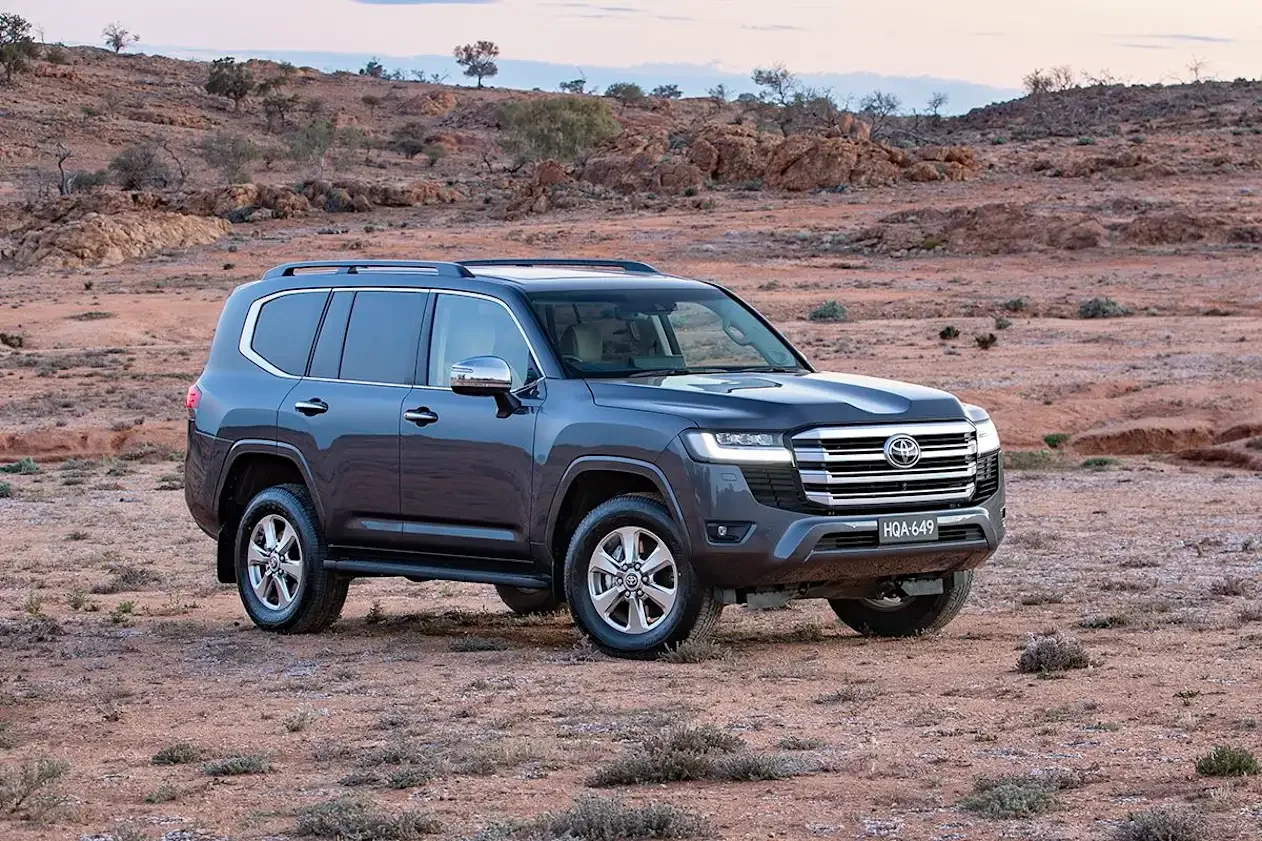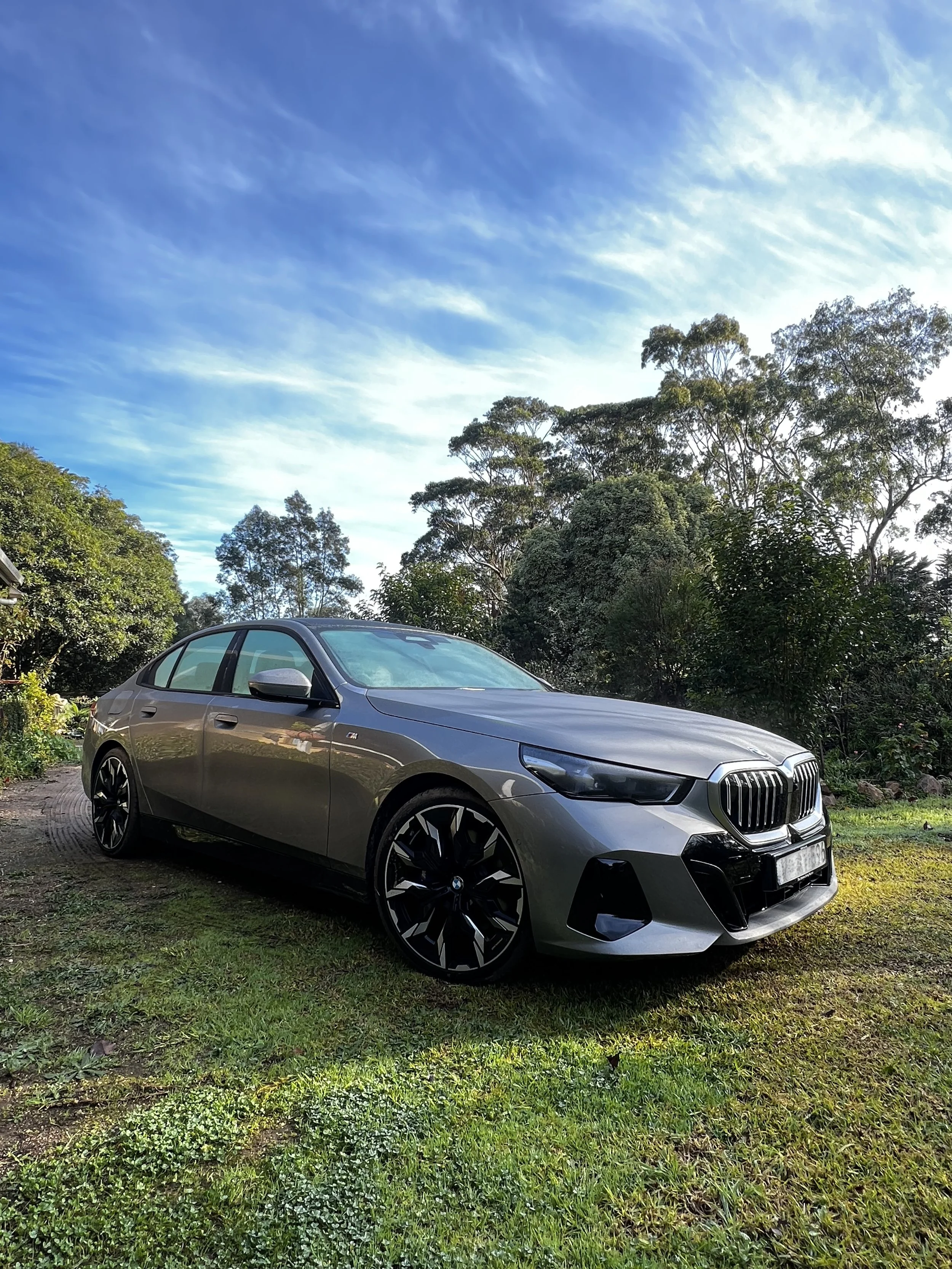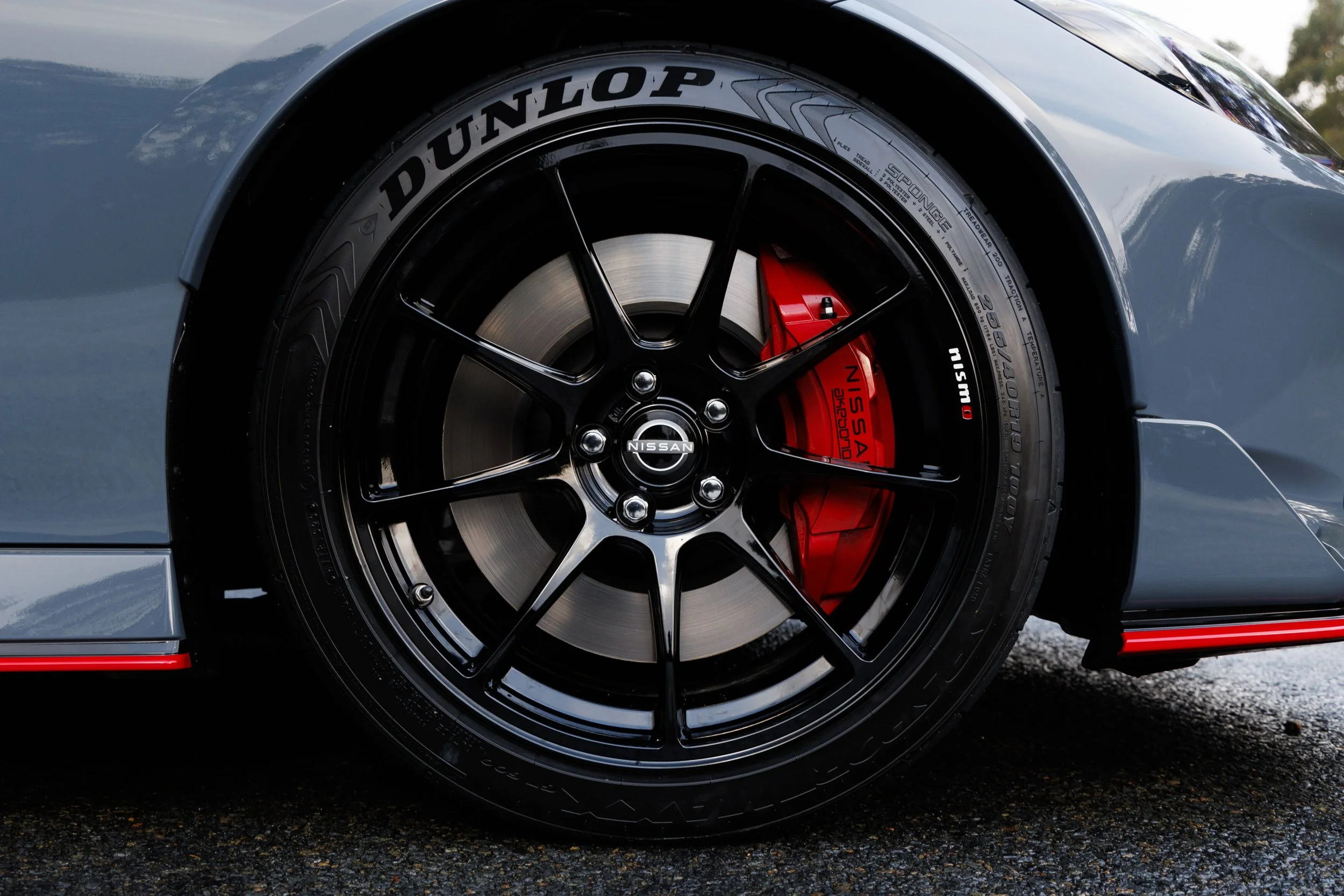Review: Toyota Land Cruiser Sahara
Few names carry the weight of the Toyota Land Cruiser. In Australia especially, it’s more than a car. It’s a badge of honour, a trusted companion, and for many, part of the family. The 300 Series Sahara continues that lineage, blending serious off-road ability with genuine luxury. Whether you’re crossing the Simpson Desert, towing a horse float, or taking the kids to school, the LC300 Sahara wants to be the one car that does it all.
Price & Key Specs
Price: From $142,101 before on-roads (Australia)
Engine: 3.3-litre twin-turbo V6 diesel
Power/Torque: 227kW / 700Nm
Transmission: 10-speed automatic, full-time 4WD with low range
0–100km/h: ~8.9 seconds
Fuel Use: 8.9L/100km (claimed)
Towing Capacity: 3,500kg braked
Ground Clearance: 235mm
Warranty: 5 years / unlimited km
Design
The LC300 isn’t flashy, and it doesn’t need to be. Its design screams functionality and presence. Upright, squared-off, and unmistakably Land Cruiser. In Sahara trim, chrome detailing and 18-inch alloys bring a touch of prestige, but it never strays into showy. LED headlights, a bold front grille, and pumped-up arches all underline that this is a 4WD with purpose.
Interior & Practical Features
Step inside the Sahara and you’re greeted with a mix of durability and luxury. Leather-appointed seats, heated and cooled up front, and soft-touch materials bring a premium feel, while the layout still feels tough enough for the bush. The 12.3-inch infotainment screen finally drags the Cruiser into the modern era, with Apple CarPlay/Android Auto, sat nav, and a crisp JBL 14-speaker system.
Space is abundant. The Sahara is a true seven-seater, with even the third row offering decent comfort for adults on shorter trips. Storage cubbies, USB ports everywhere, a chilled centre console, and tri-zone climate keep the family happy. Boot space with all rows up is tight (around 175L), but fold the third row and you unlock a much larger 1,004L. Take it one step further and fold down the second row, and you’ll end up with 1967L of cargo space.
Driving Impressions
Fire up the 3.3 twin-turbo V6 and there’s a refined diesel thrum. Quieter than the old V8, but still purposeful. On the road, the Sahara feels smoother and more composed than ever. The 10-speed auto keeps the engine right in the fat of its torque band, delivering effortless shove whether you’re overtaking or towing a caravan.
Despite its size, the LC300 doesn’t feel unruly. The suspension soaks up rough country roads with ease, and there’s a surprising polish to the way it handles city bumps and potholes. Steering is light enough for daily driving but still gives you the sense of control you want in something this large. Cabin refinement has taken a big step up. Wind and road noise are hushed, making long highway drives genuinely relaxing.
Take it off-road, and the Sahara reminds you why the Land Cruiser name is sacred. Multi-Terrain Select, Crawl Control, a locking centre diff, and serious suspension articulation mean this thing will clamber up, down, and across just about anything. Combine that with 235mm ground clearance and a wading depth of 700mm, and you’ve got an SUV that laughs at obstacles rivals would balk at.
Safety Tech
Toyota has stacked the LC300 with Toyota Safety Sense: adaptive cruise, lane-keep assist, blind-spot monitoring, rear cross-traffic alert, and AEB with pedestrian and cyclist detection. A 360-degree camera system makes parking its size far easier, and with ANCAP’s 5-star rating, the big Cruiser ticks every box for family safety.
Ownership Experience
Toyota backs the LC300 with a 5-year/unlimited kilometre warranty, extendable to 7 years for the powertrain with proper servicing. Fuel use hovers around 10–11L/100km in real-world conditions, which is impressive given the weight and size. Servicing is capped-price and intervals are every 6 months/10,000km — a bit frequent compared to some rivals, but part of Toyota’s play-it-safe philosophy.
Verdict
The 2024 Toyota Land Cruiser 300 Sahara isn’t just a car, it’s a statement. It combines unstoppable off-road ability with genuine luxury and daily usability. Whether you’re in the outback, towing a boat, or pulling into the valet line, the LC300 looks and feels right at home.
For the drivers? Absolutely. Just in a different sense. This isn’t about carving corners, it’s about commanding respect, conquering terrain, and knowing that no matter the destination, the Land Cruiser will get you there in comfort and confidence.
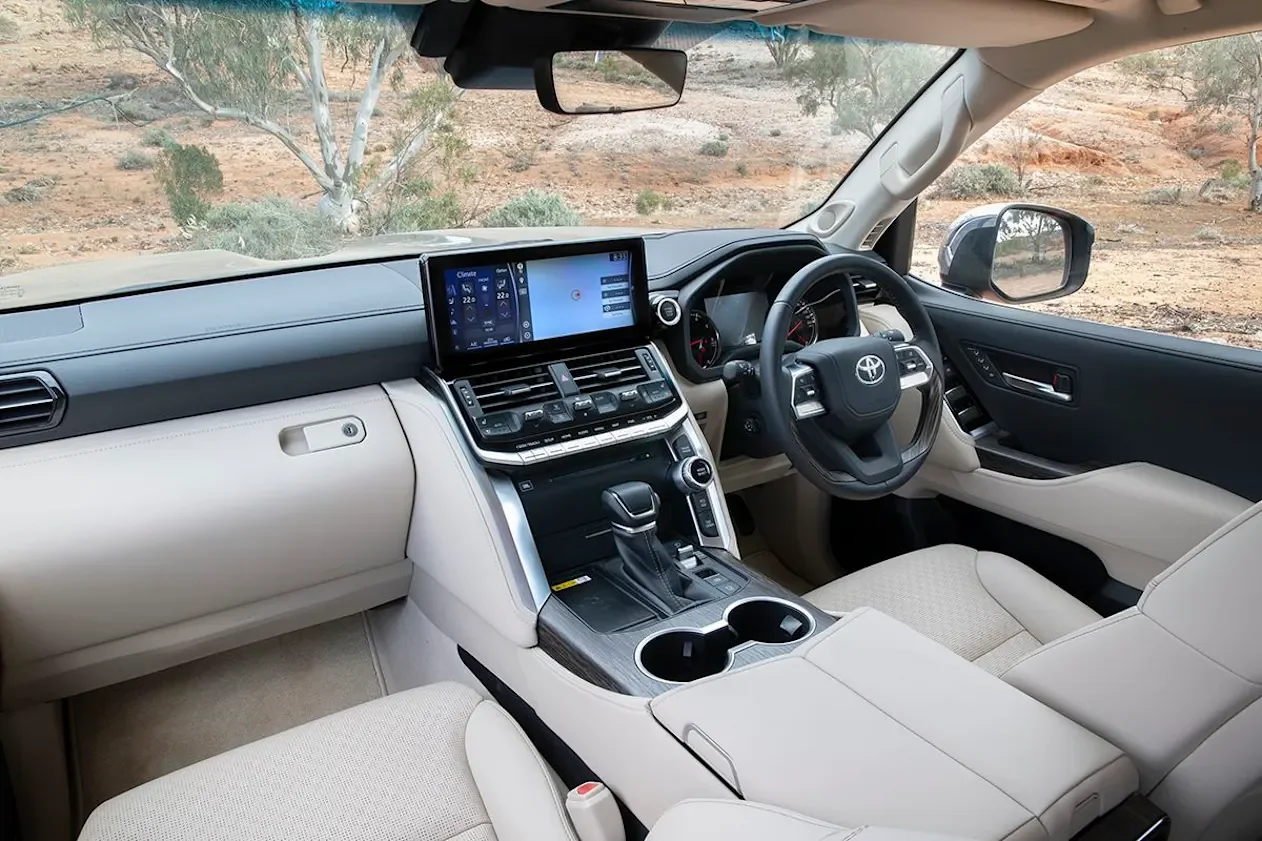

Review: BMW X7 40d
The BMW X7 sits right at the top of BMW’s SUV lineup. And it knows it. It’s the kind of machine you spot in the rear-view mirror and instantly know something substantial is behind you. In 40d guise, it blends efficiency, diesel torque, and modern luxury in a way that makes it both a family-hauler and a long-distance tourer. For those who think of BMW only as a driver’s brand, the X7 shows Munich can do big, plush, and commanding just as well.
Price & Key Specs
Price: From around $174,900 plus on-roads
Engine: 3.0-litre inline six-cylinder turbo-diesel, 48V mild-hybrid
Power/Torque: 259kW / 720Nm
Transmission: 8-speed automatic, xDrive AWD
0–100km/h: 5.9 seconds
Fuel Use: ~8.2L/100km
Towing Capacity: 3,500kg braked
Warranty: 5 years / unlimited km
Design
The X7 isn’t subtle. Its sheer size, massive kidney grille, split headlights, and crisp body lines make sure it dominates any driveway. The M Sport package sharpens things up with larger wheels, sportier bumpers, and shadowline trims. But even in standard form, this is a rolling statement of success. BMW has softened some of the facelift criticism with sleeker lighting signatures, giving the X7 a fresher, more modern edge.
Interior & Practical Features
Step inside and the X7 doesn’t just feel premium — it feels indulgent. The curved display (12.3-inch driver + 14.9-inch infotainment) wraps around you (with iDrive 8.5 running the show), the ambient lighting subtly sets the mood, and the quilted leather seats invite you to sink in and stay awhile. There’s a hushed quiet once the doors close, as though the outside world gets left behind. Even on coarse roads, the insulation is so good you end up whispering instead of raising your voice.
The seats are wide, supportive, and endlessly adjustable, giving you the sensation of sitting in a private jet more than a family SUV. Row two is limousine-like, with space to stretch, and even row three feels like it was designed for adults rather than afterthought passengers. The 20-speaker Bowers & Wilkins system floods the cabin with crisp, concert-hall clarity — perfect for when you’re eating up kilometres on a long haul with multiple USB-C ports making it as tech-laden as any luxury lounge.
Quality is, as expected, impeccable: soft-touch leather, crafted trims, and ambient lighting everywhere. Seating for seven comes standard, with heated and ventilated seats available in all rows depending on spec. Space is generous in every direction, even for adults in the third row. Boot space sits at 750L (five seats up), expandable to over 2,000L.
Accessing the third row in the X7 isn’t the quickest process. The electrically sliding second-row seats take their time, and the gap they leave is a little tighter than you’d hope. In practice, kids often find it easier to just slip through the centre of the captain’s chairs.
Once you’re back there, though, it’s clear BMW hasn’t treated the third row as an afterthought. The seats are genuinely usable for everyday journeys, offering good comfort, their own air vents, cupholders, and even extra charging points — perfect for keeping devices alive on family road trips. Thanks to the X7’s large glasshouse, visibility remains excellent, so it doesn’t feel like you’re stuffed into a dark corner.
Another clever touch is the split tailgate. It takes a couple of extra seconds to lower the bottom section, but the ease of loading heavier items in or just sitting on it at the weekend makes it one of those small features you quickly learn to appreciate.
This is BMW’s flagship SUV, and it communicates that in every interaction: the soft click of the switchgear, the chilled precision of the glass controls, and the effortless way tech integrates without intruding. It’s not just a cabin; it’s a rolling sanctuary.
Driving Impressions
Slip behind the wheel of the X7 40d and the first thing that hits you is the sheer sense of calm. Press the starter and the inline-six hums to life so smoothly that, without glancing at the tach, you’d hardly know the engine was on. Around town, the X7 glides with an effortless composure — the diesel’s 720Nm of torque wafts you forward with barely a flex of your right foot. It doesn’t surge, it surfs on a constant wave of torque, giving you the sense you could keep going forever without the car breaking a sweat.
Out on the open road, the X7 is a consummate cruiser. Plant your foot for an overtake of some long trucks along the back roads of Gippsland and the mild-hybrid system joins the straight-six to deliver a swell of torque that shoves you forward, surprising anyone who assumes something this large should feel sluggish. The 8-speed ZF box is telepathic — always in the right gear, always smooth.
In corners, it defies its bulk. The air suspension hunkers down and controls body roll so well you forget you’re piloting nearly 2.5 tonnes of SUV. The steering has BMW’s hallmark precision — light at low speeds, but with enough feedback to place this seven-seater confidently on a country road. It’s no X5 M50i, but the confidence it inspires is uniquely BMW: composed, planted, and reassuringly athletic.
Safety Tech
The 2025 X7 is loaded with driver assistance: adaptive cruise with stop & go, lane-keep assist, blind-spot monitoring, surround-view cameras, and BMW’s Parking Assistant Professional that can even memorise and retrace tricky parking manoeuvres. ANCAP hasn’t crash-tested the facelifted X7, but the tech suite is comprehensive and in line with the flagship positioning.
Ownership Experience
BMW offers a 5-year/unlimited kilometre warranty and service-inclusive packages that can be prepaid for predictable costs. Diesel economy of ~8.2L/100km is impressive given the size, and with a 80L tank, you’re looking at over 900km of touring range. For families, the X7 nails practicality with its towing ability, seven-seat flexibility, and tech to keep everyone comfortable.
Verdict
The 2025 BMW X7 xDrive40d is less about carving apexes and more about conquering continents. It’s an SUV that blends commanding road presence with genuine everyday usability, all while delivering luxury and refinement on par with rivals from Mercedes and Audi. For buyers who want BMW’s badge and engineering in the most spacious, plush form available, the X7 40d hits the sweet spot.
For the drivers? Not in the traditional M-car sense. But for those who want the ultimate BMW SUV experience without compromising on comfort, efficiency, or practicality — the X7 40d stands tall.
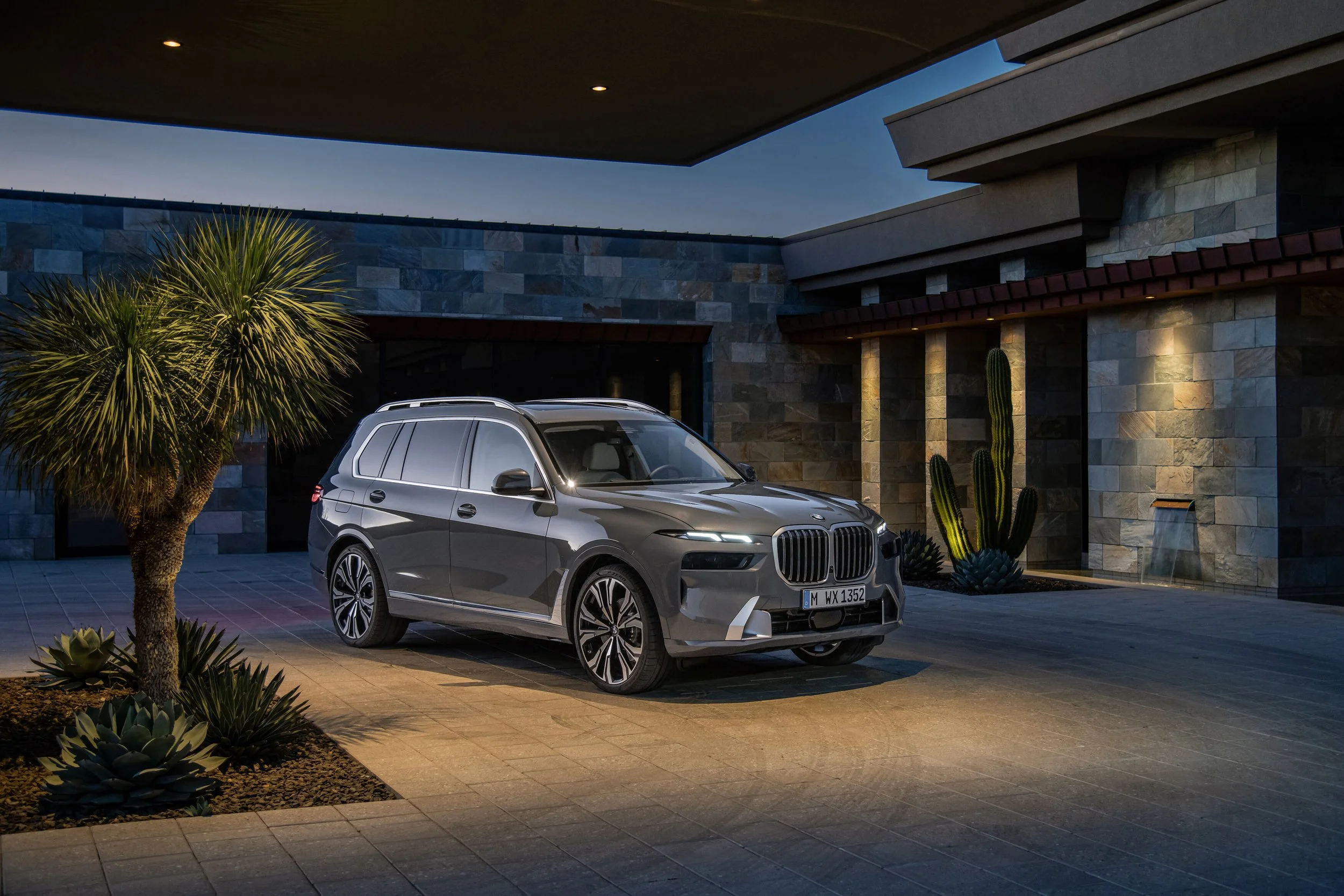
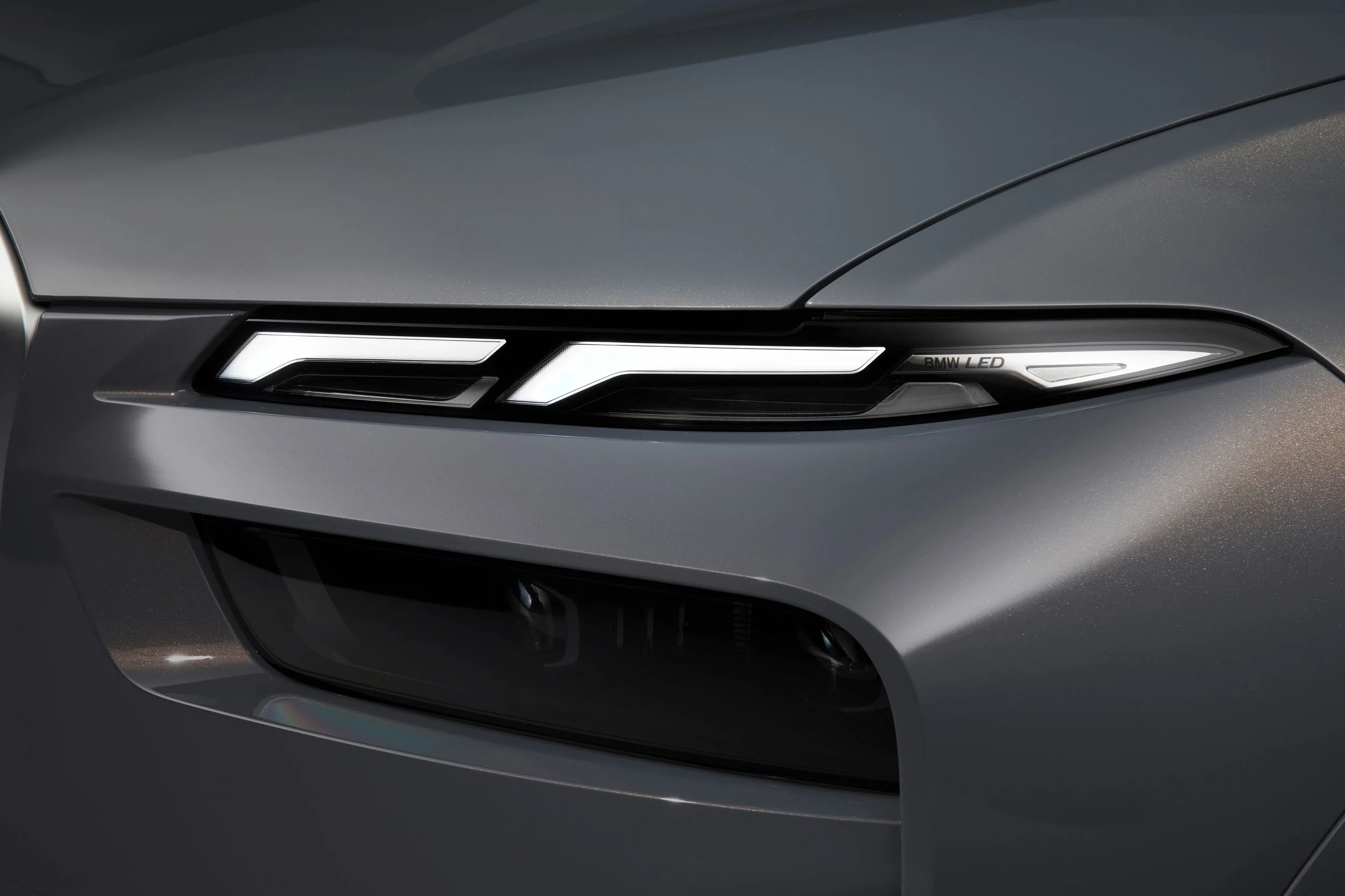
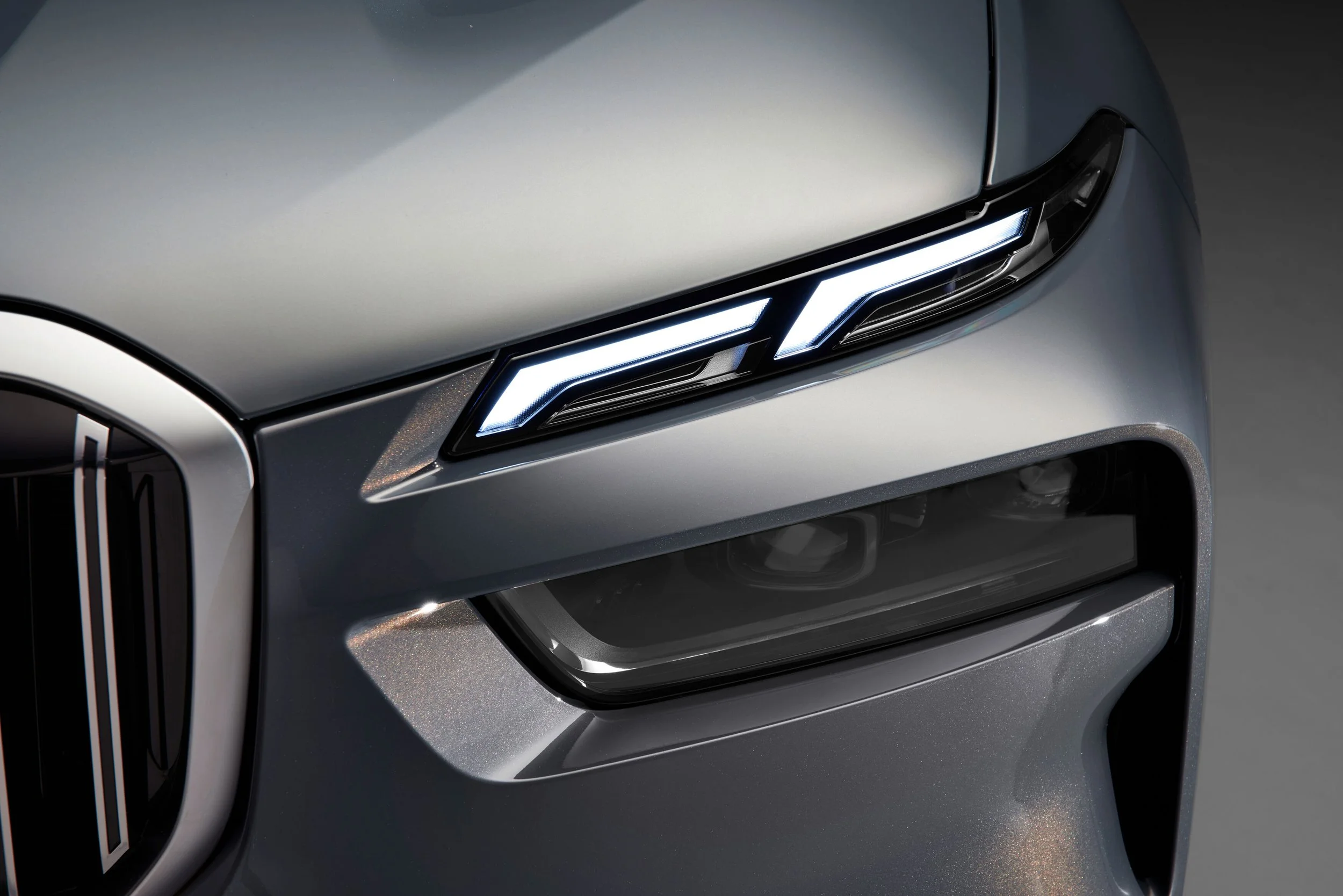
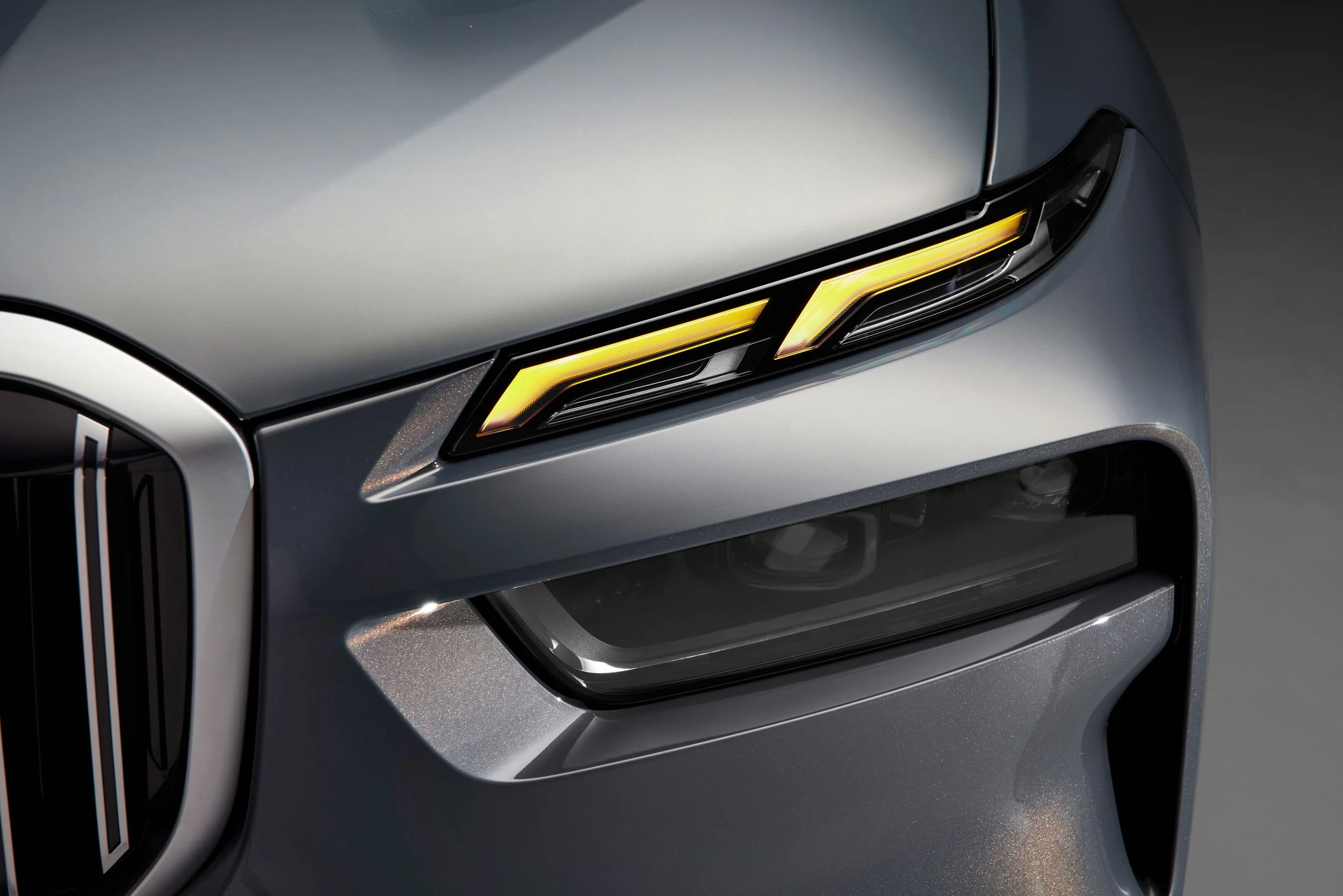
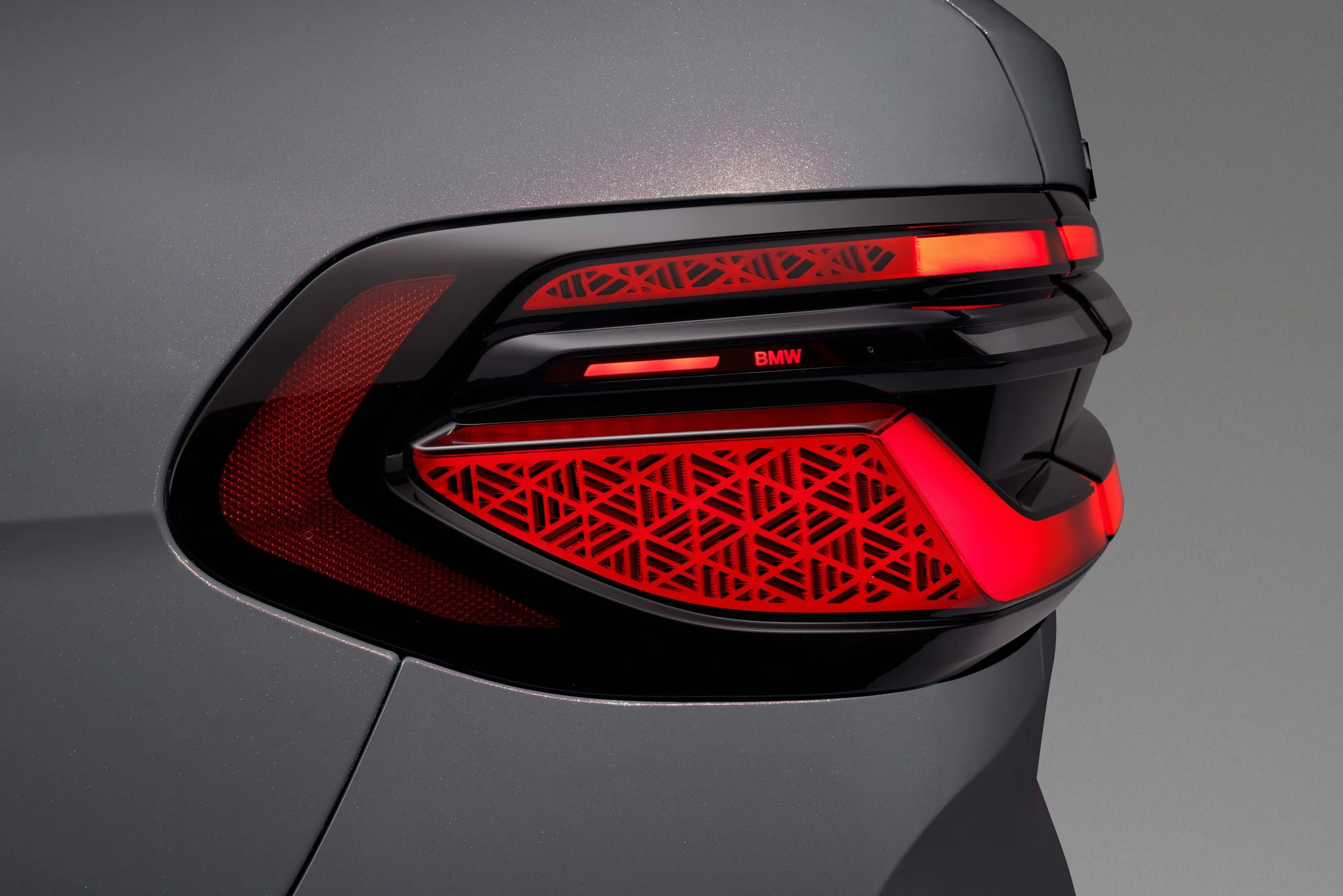
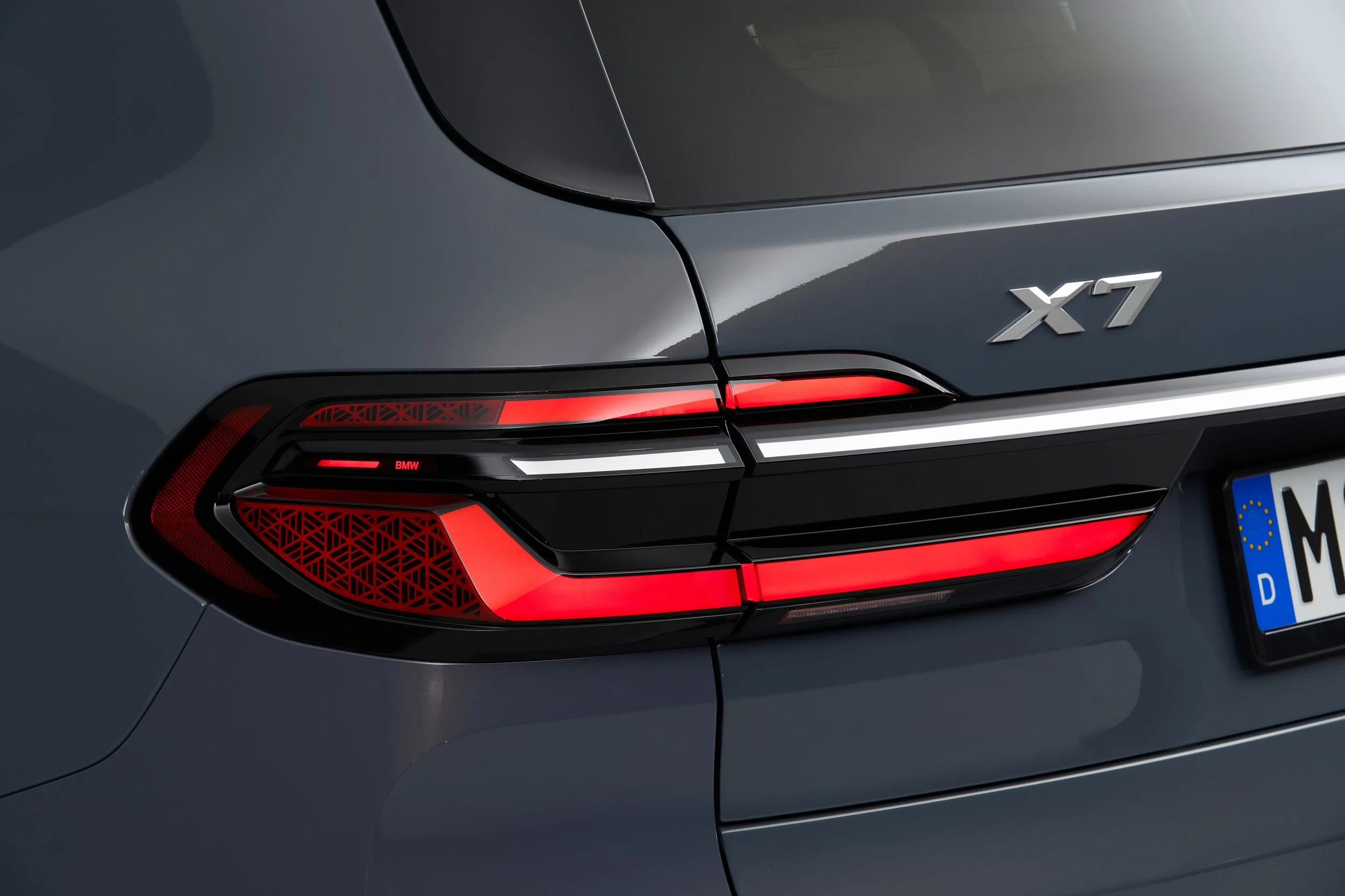
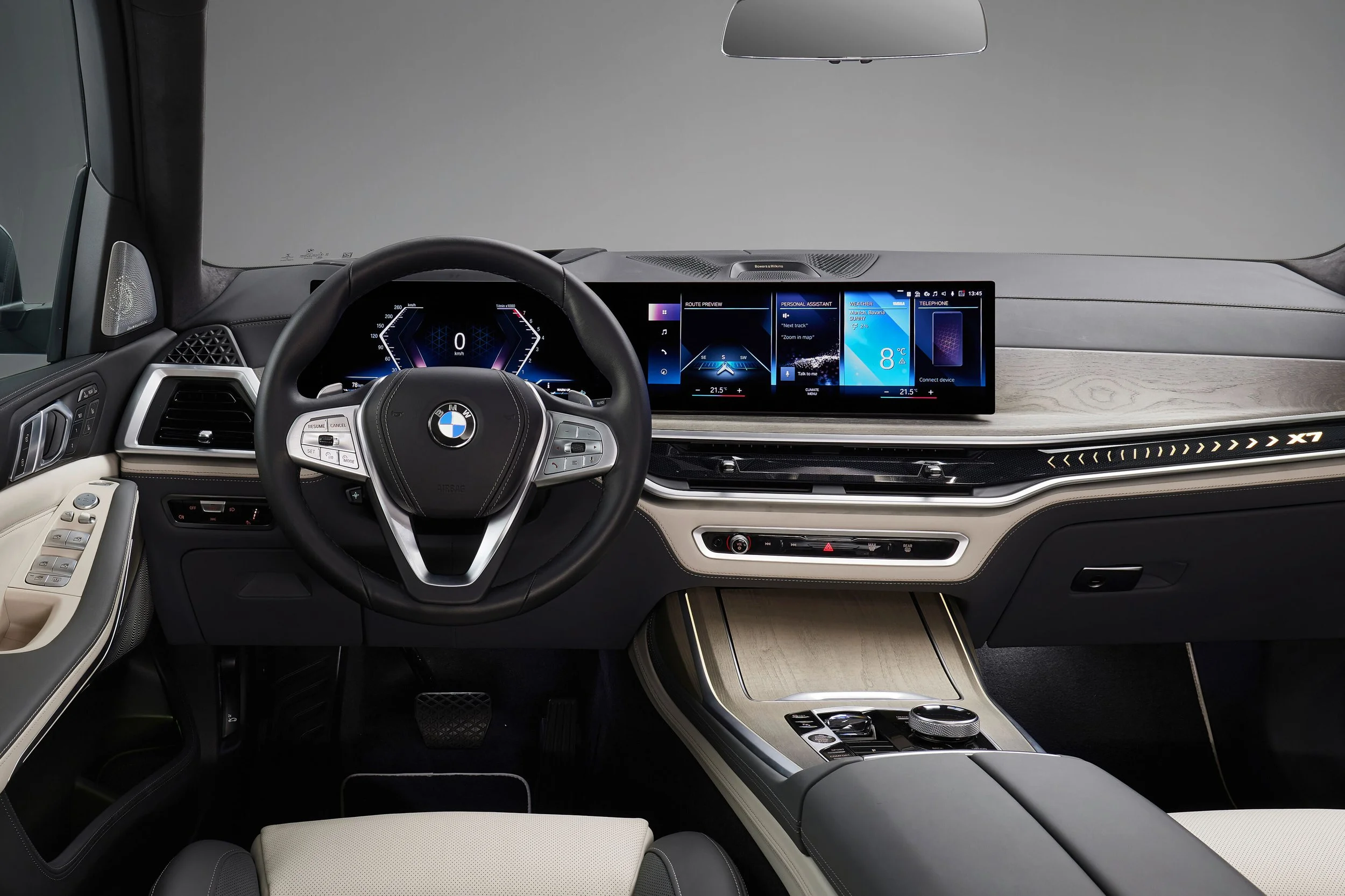
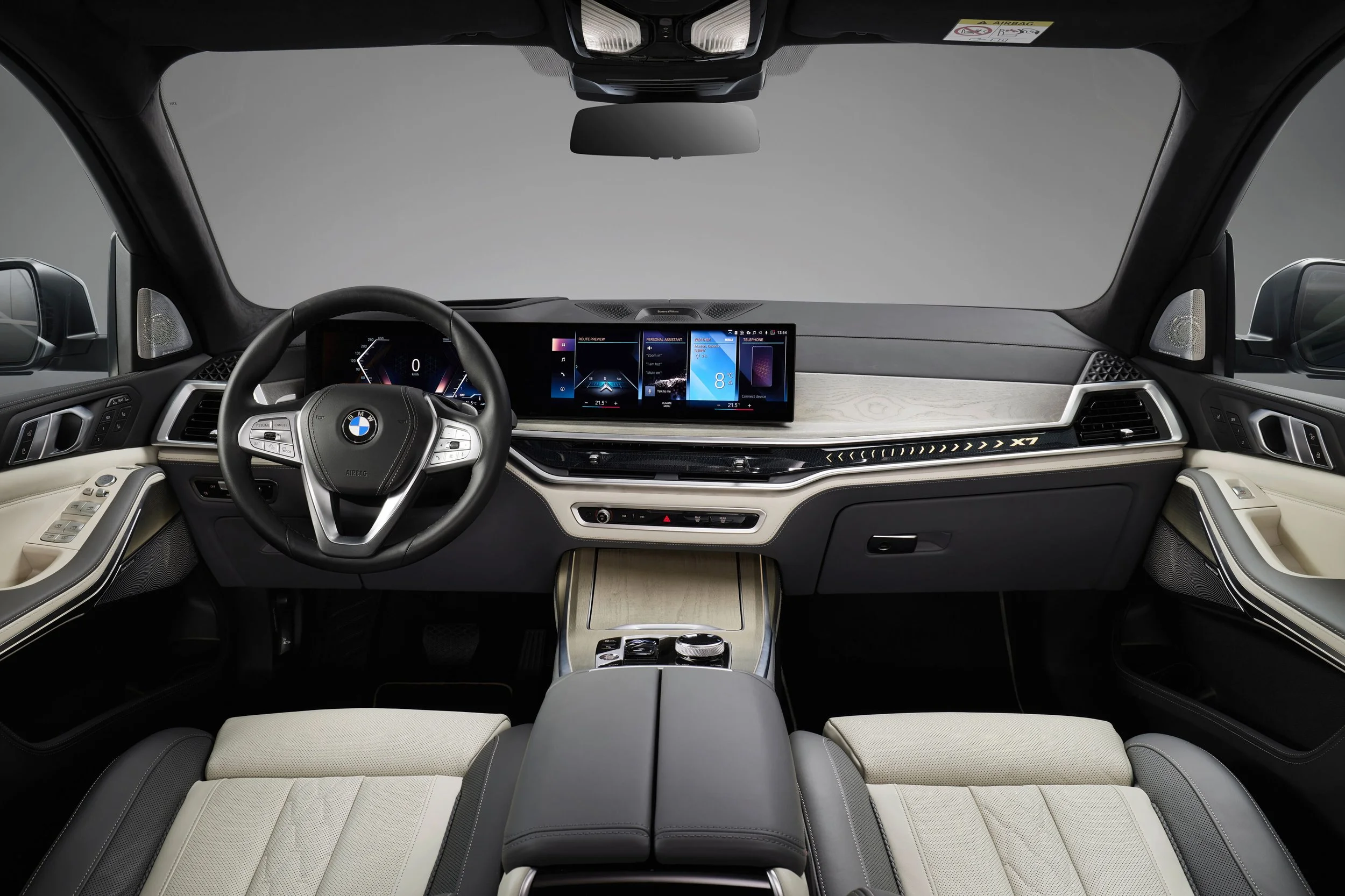
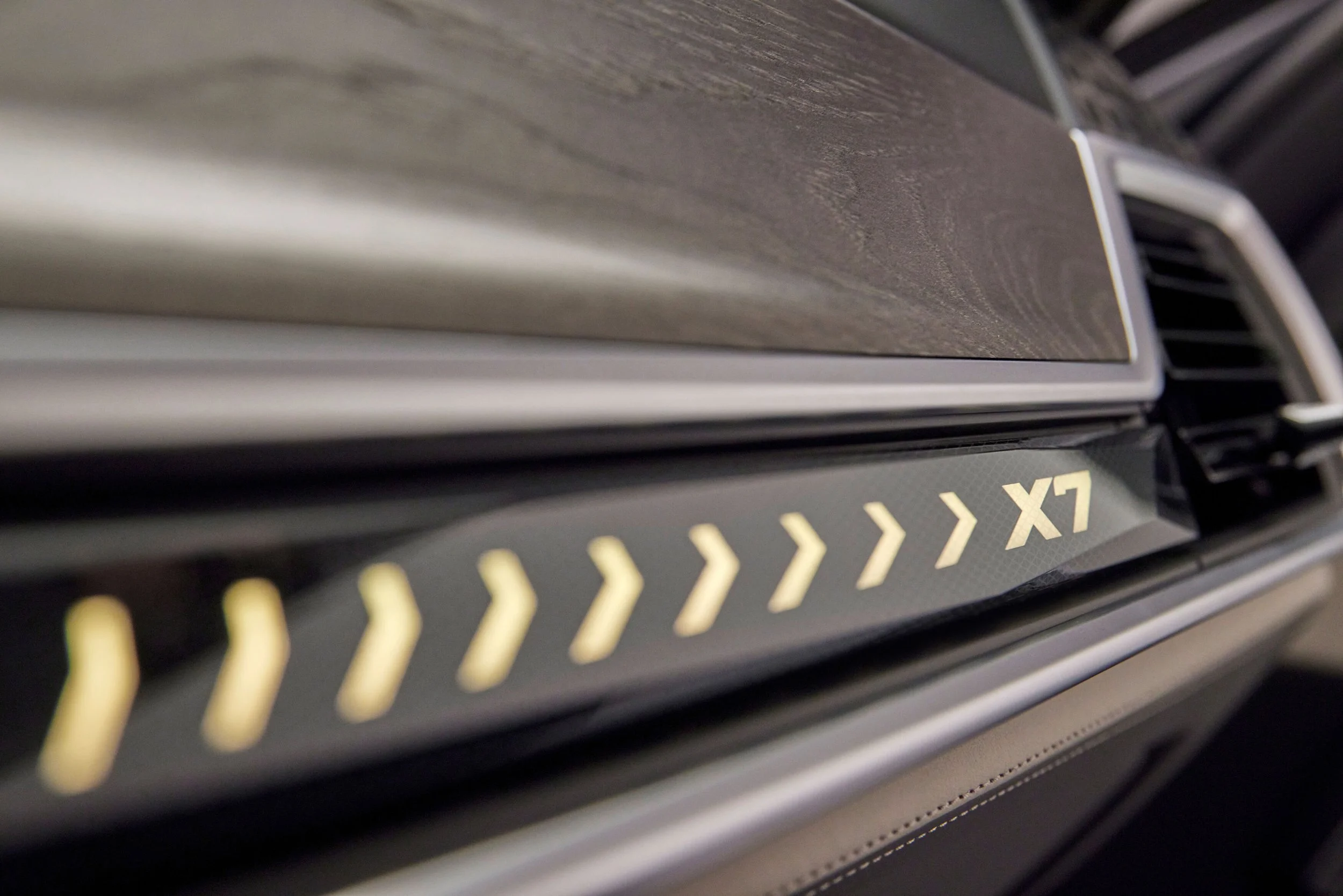
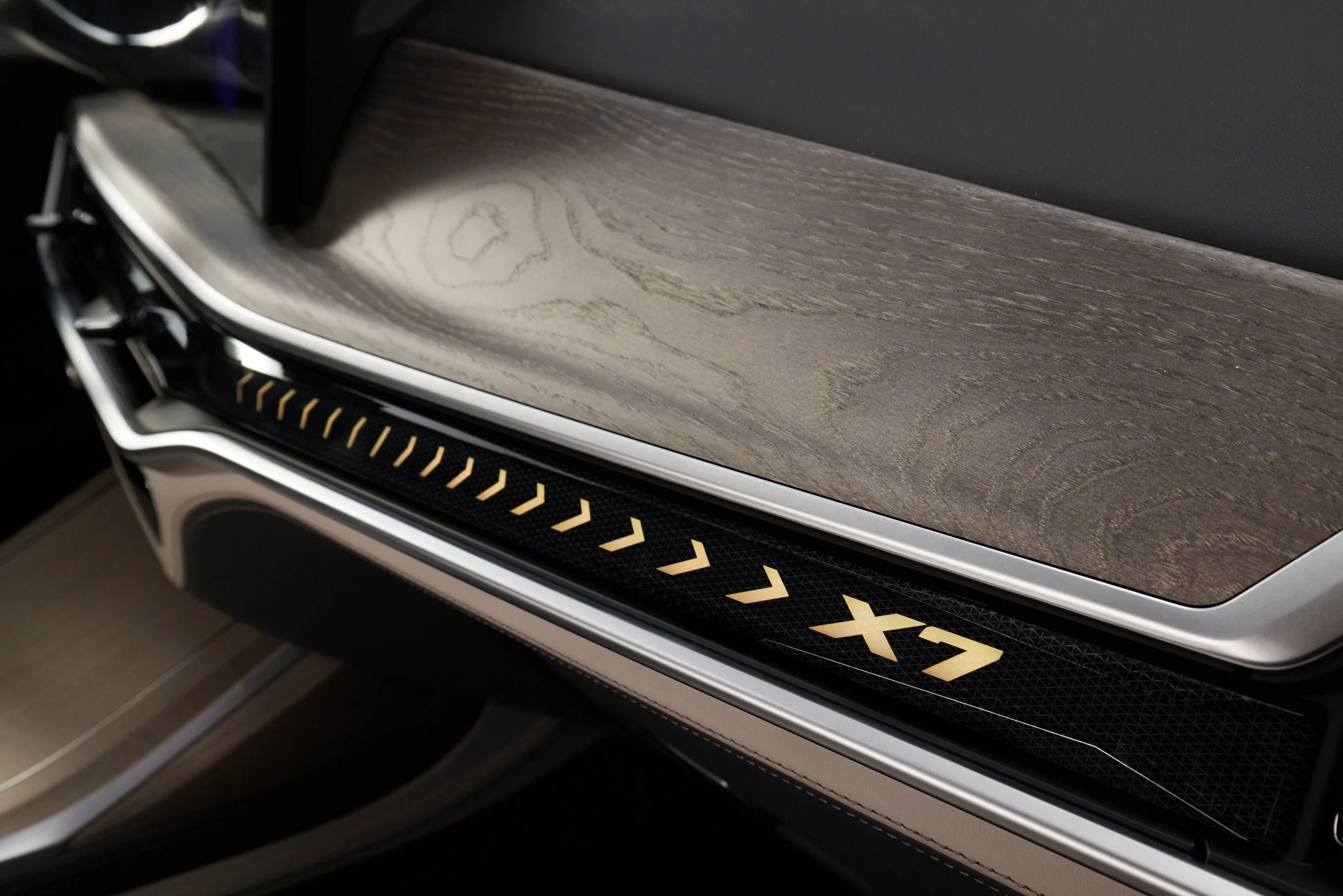
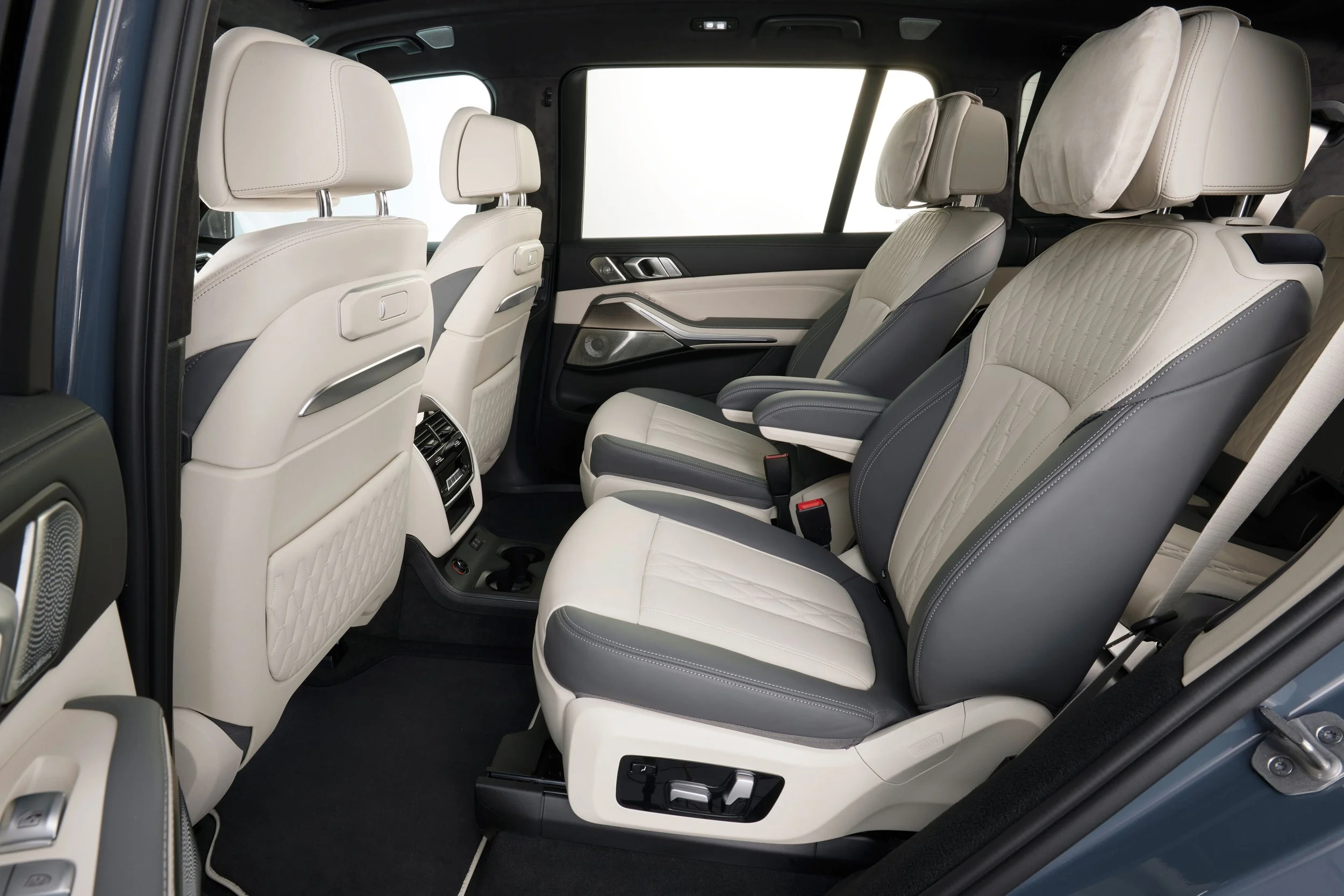
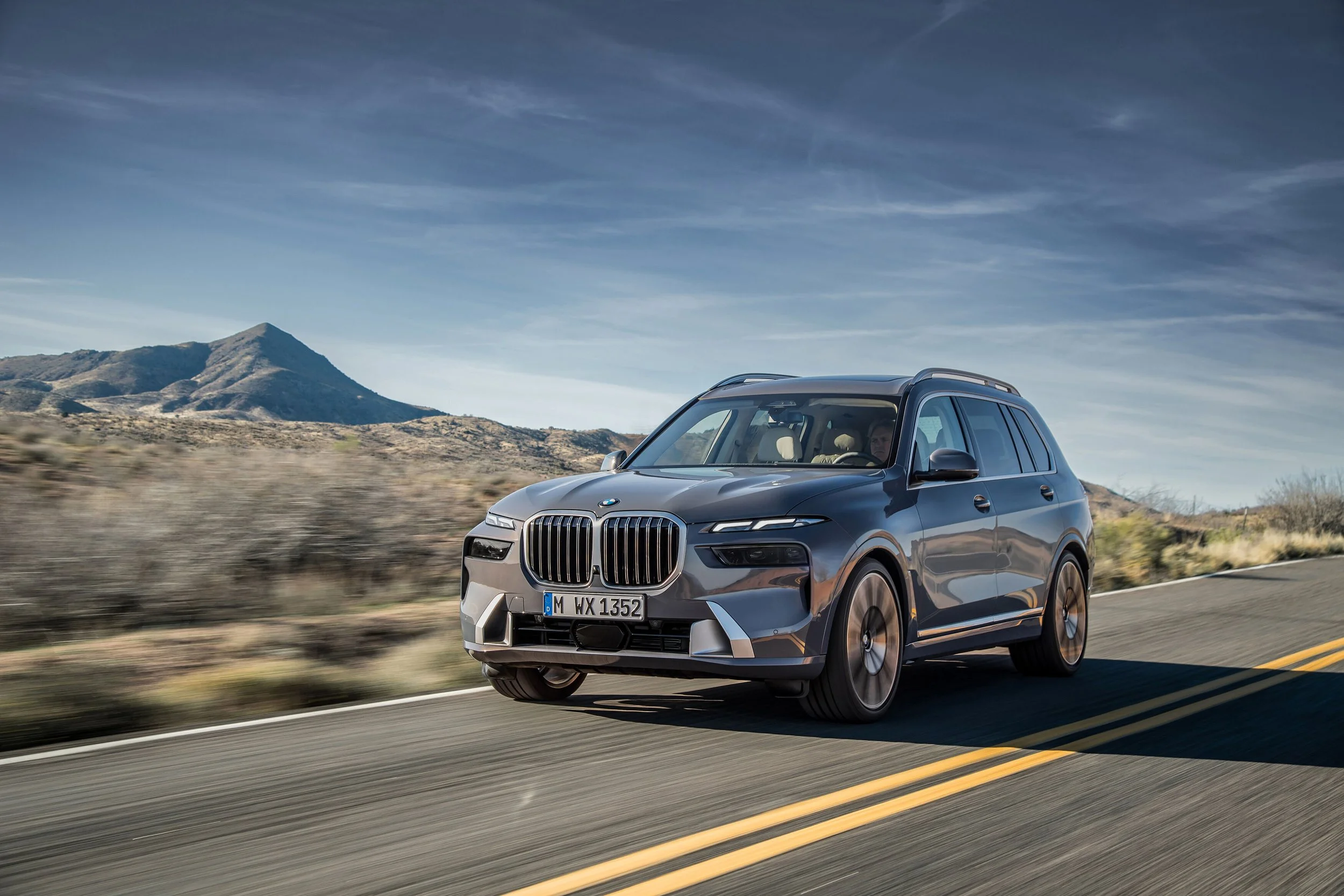
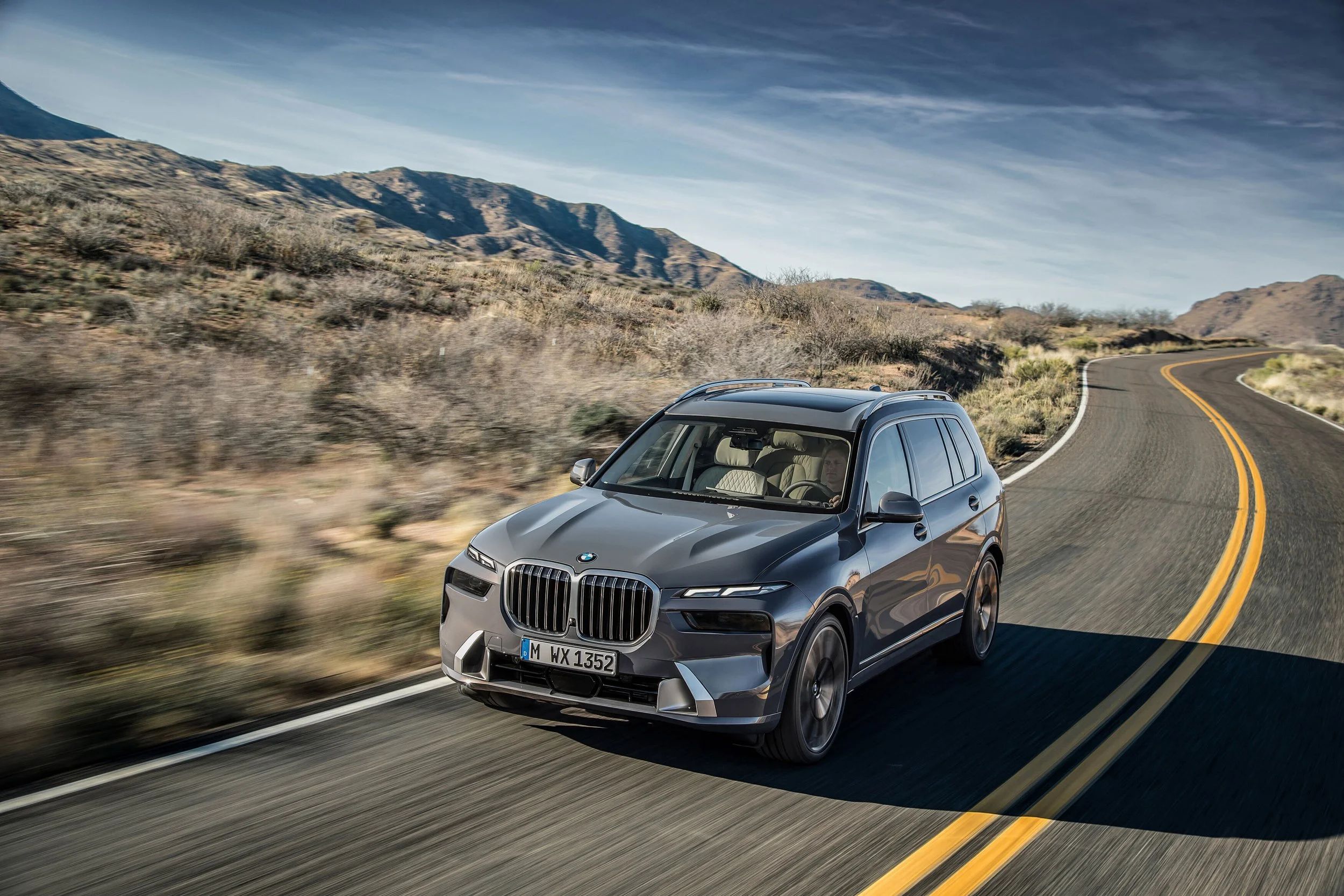
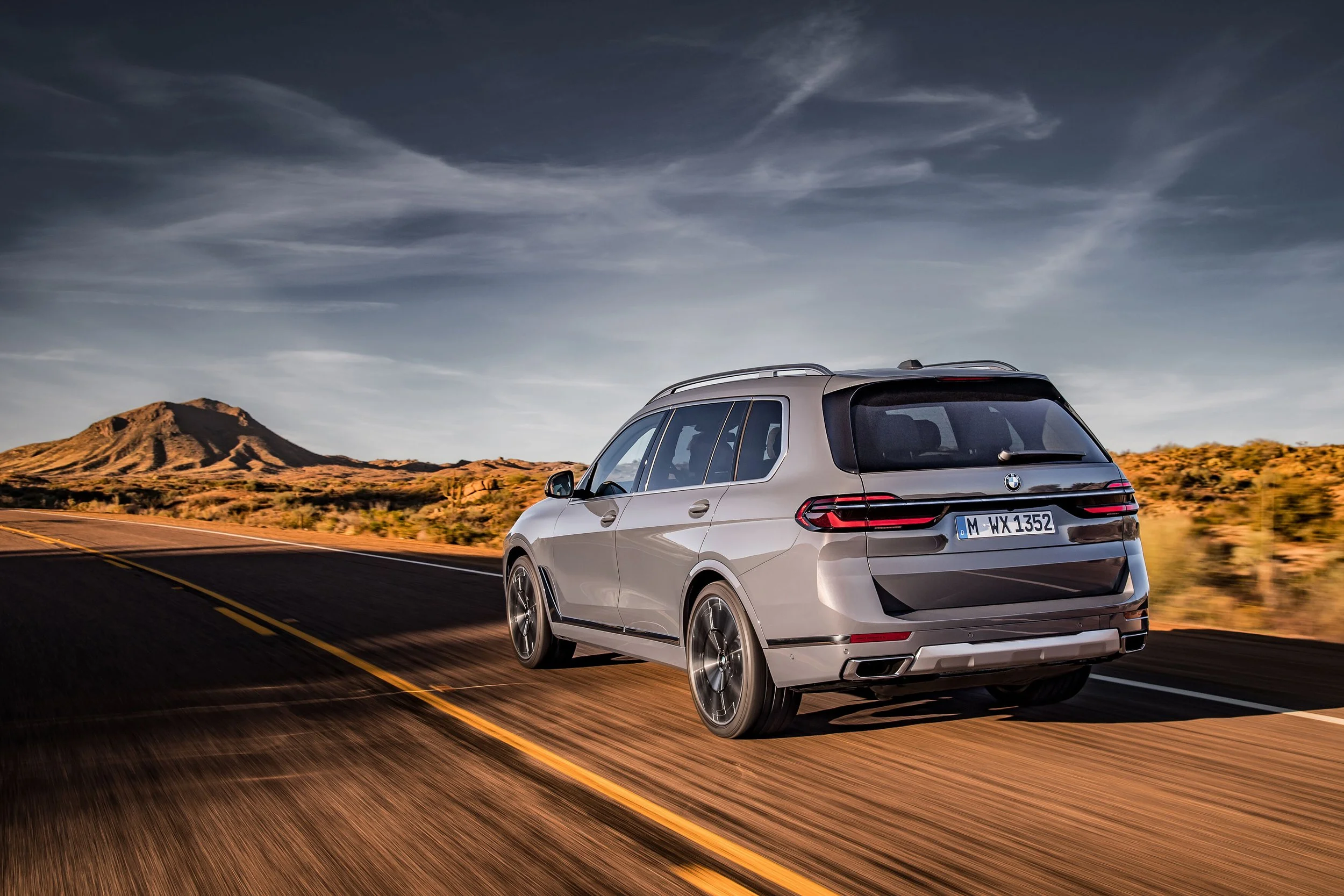

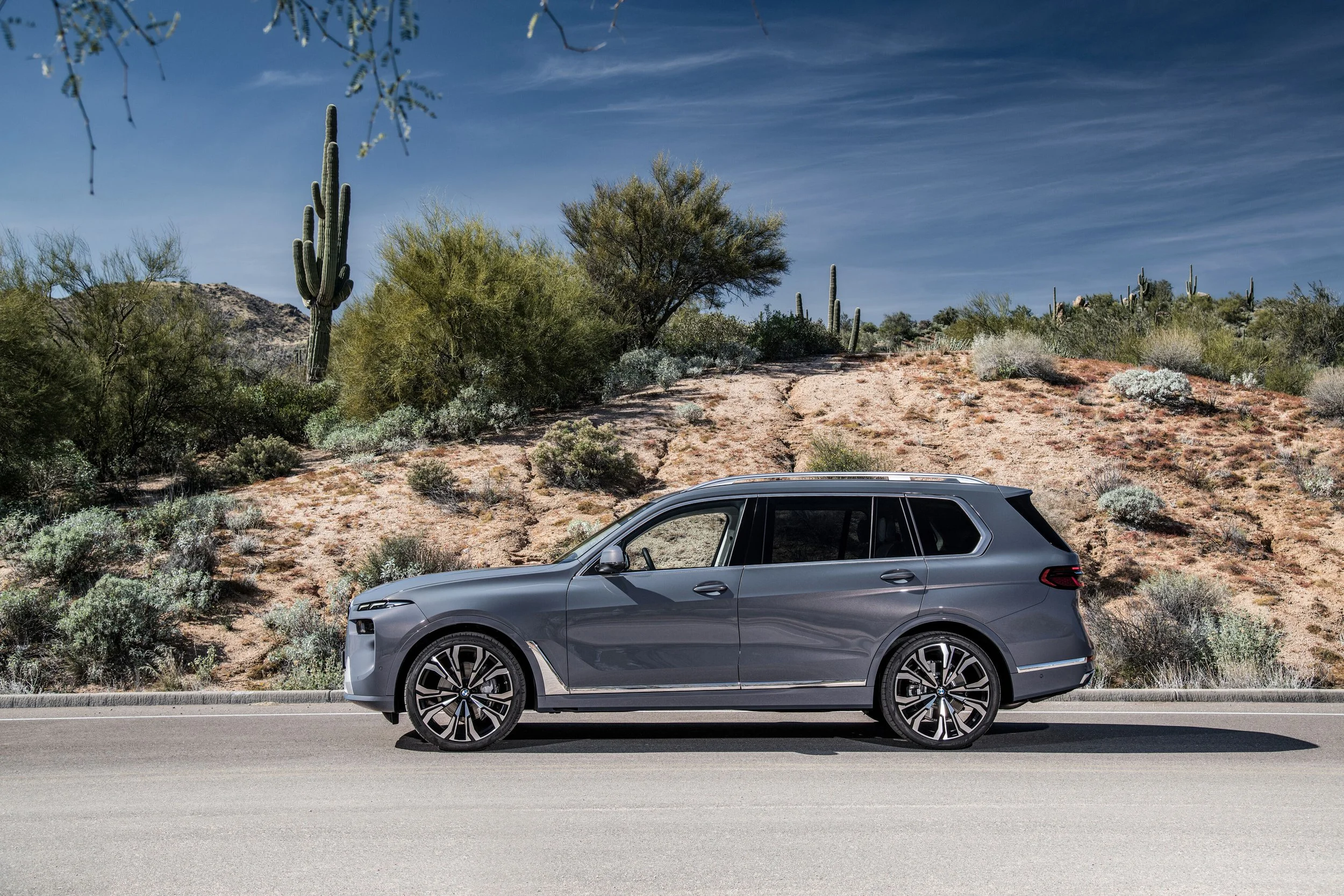
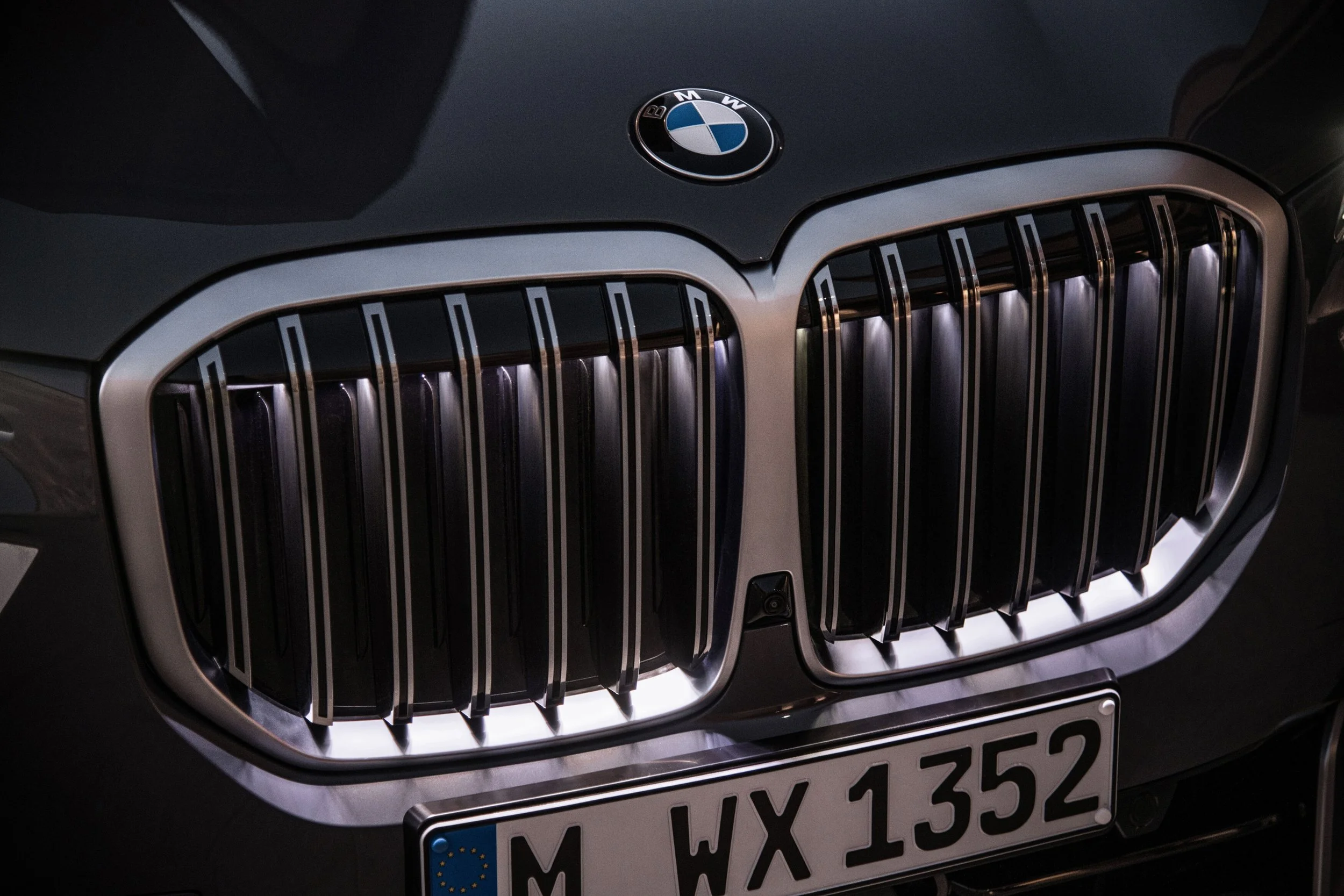

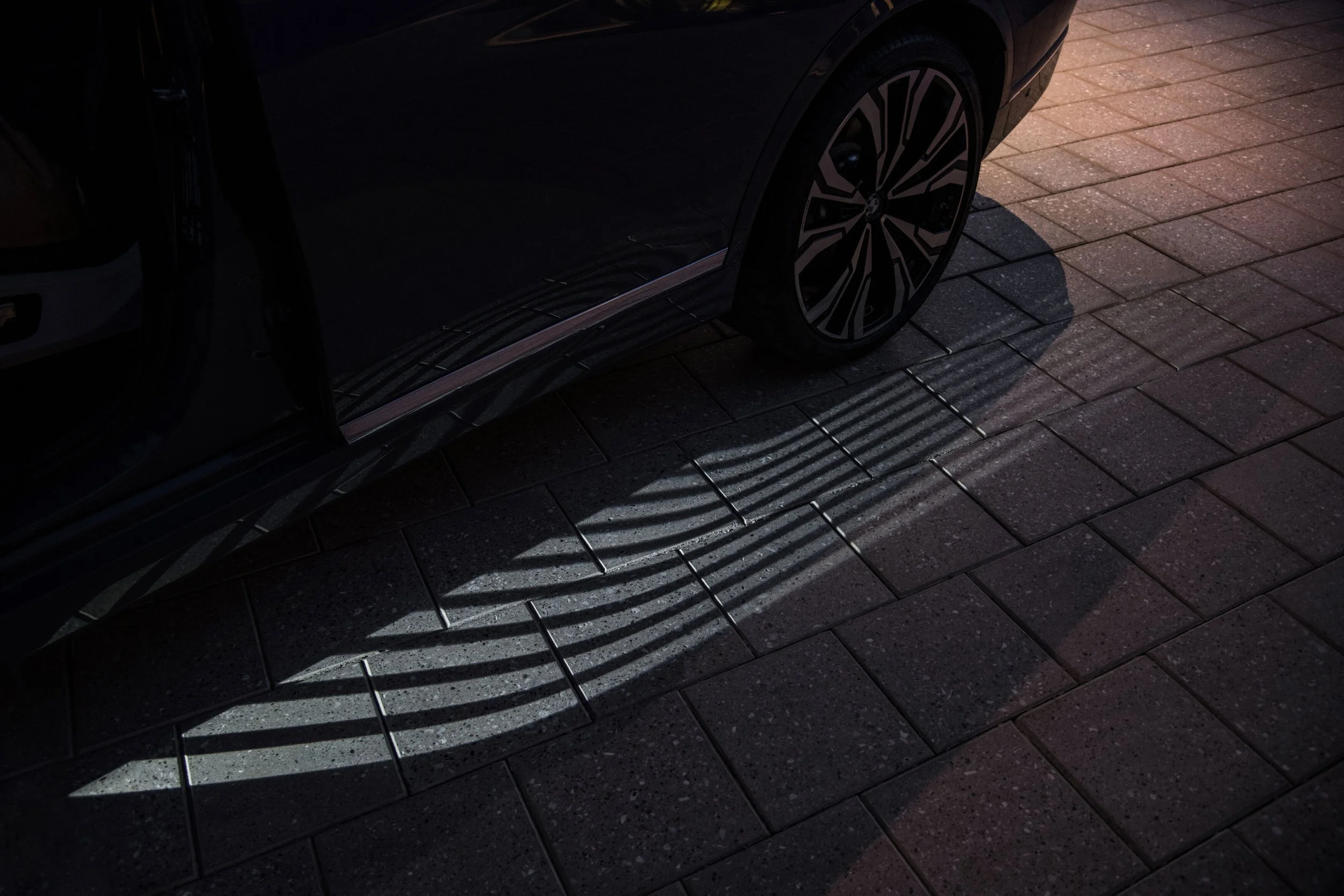
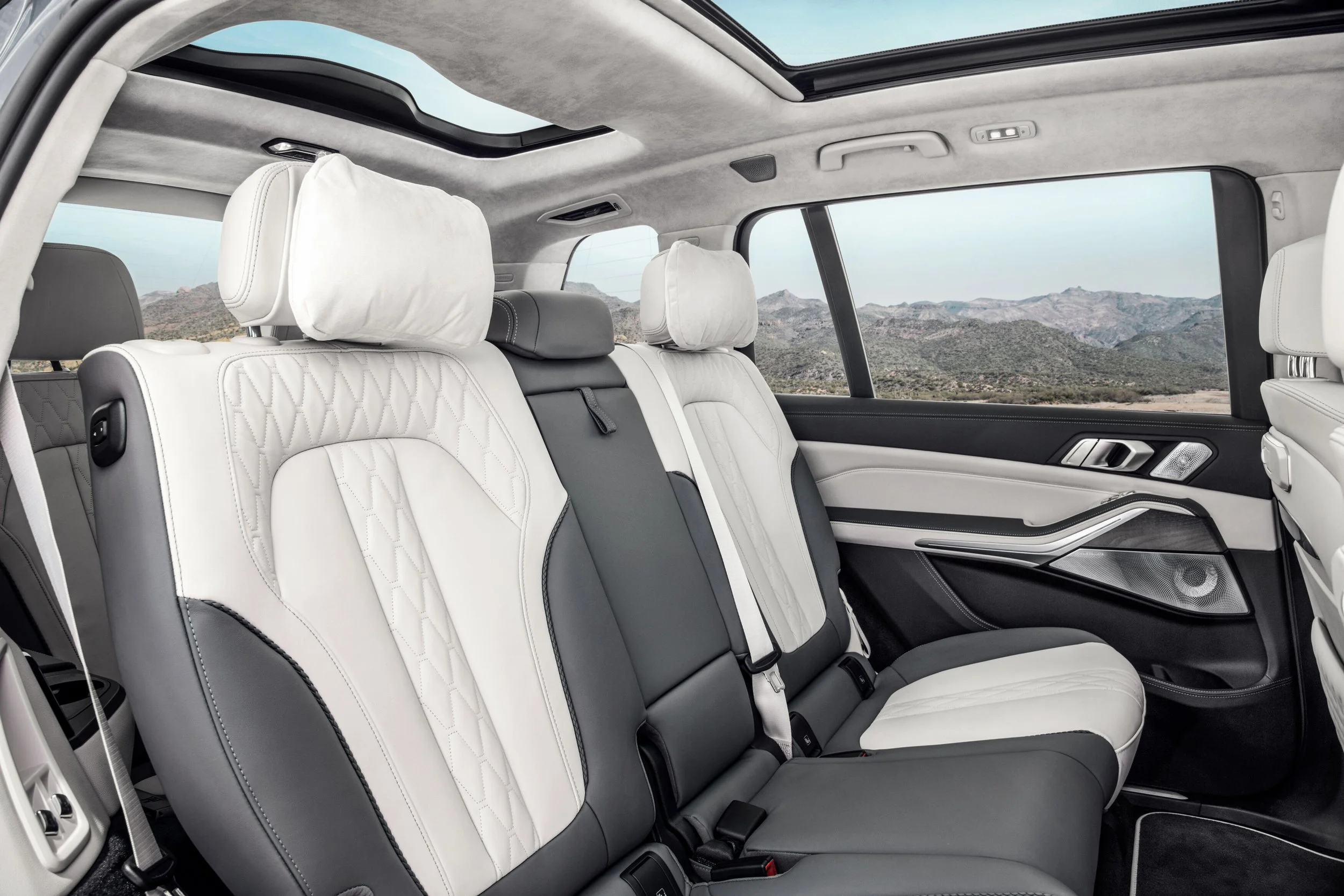
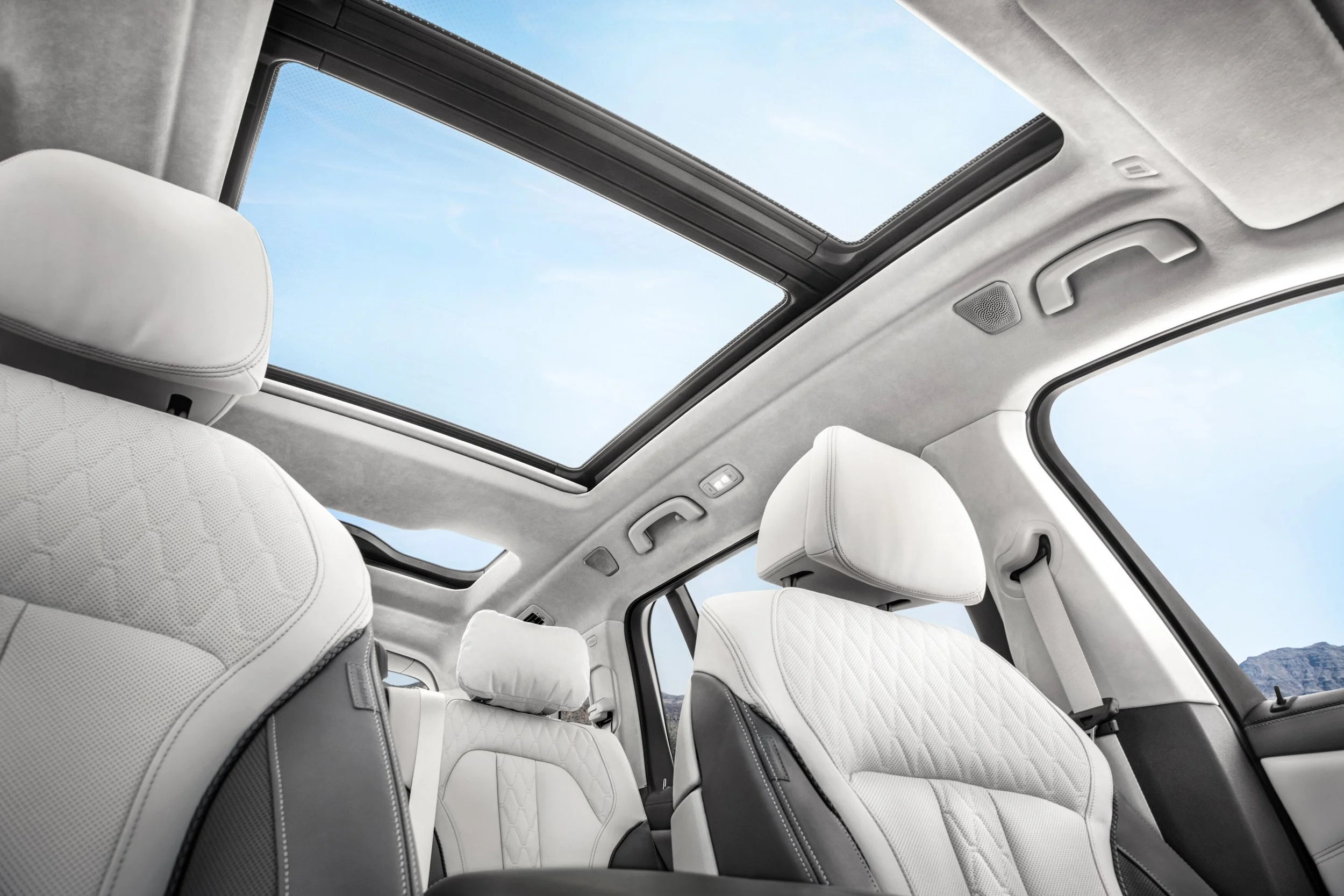
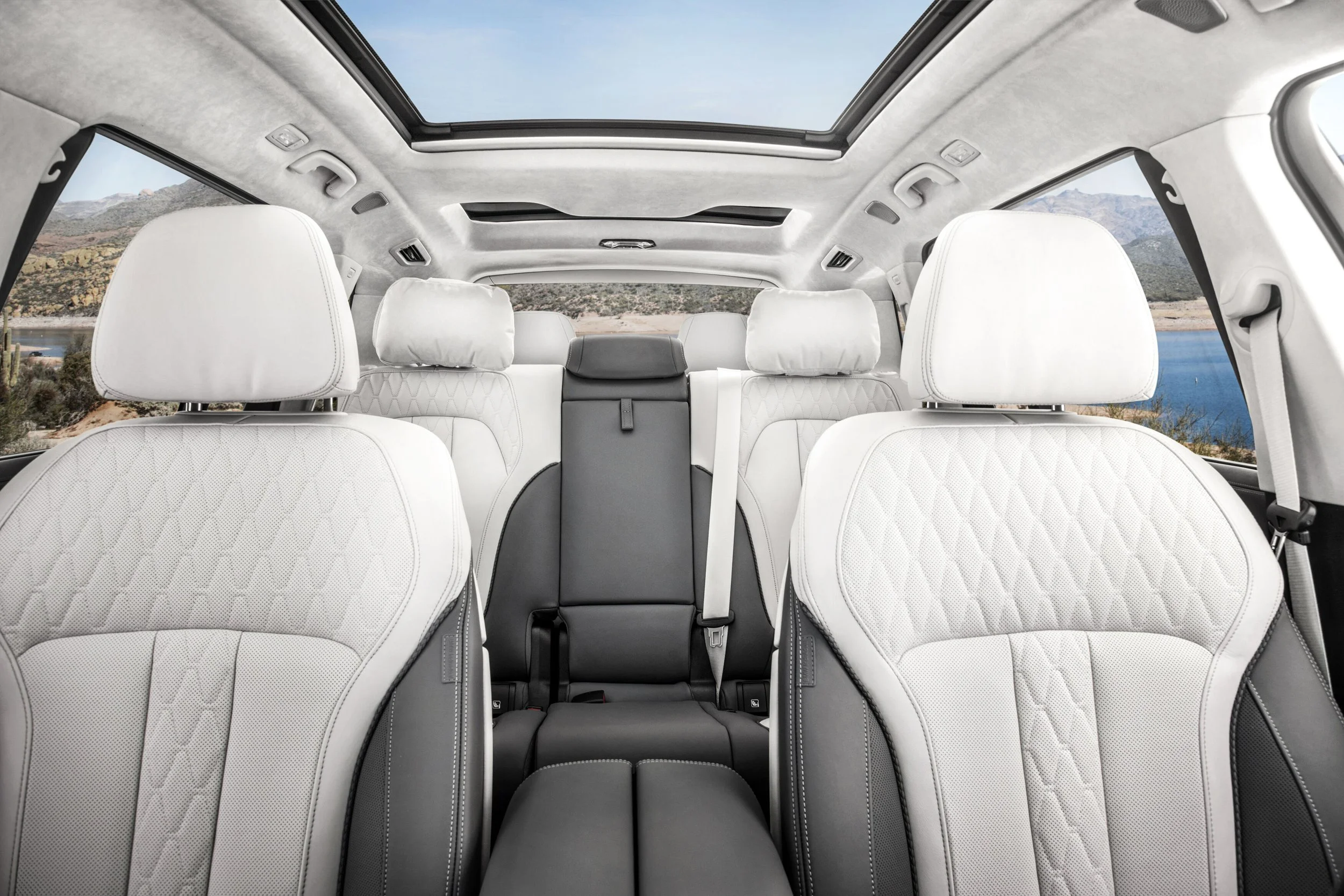
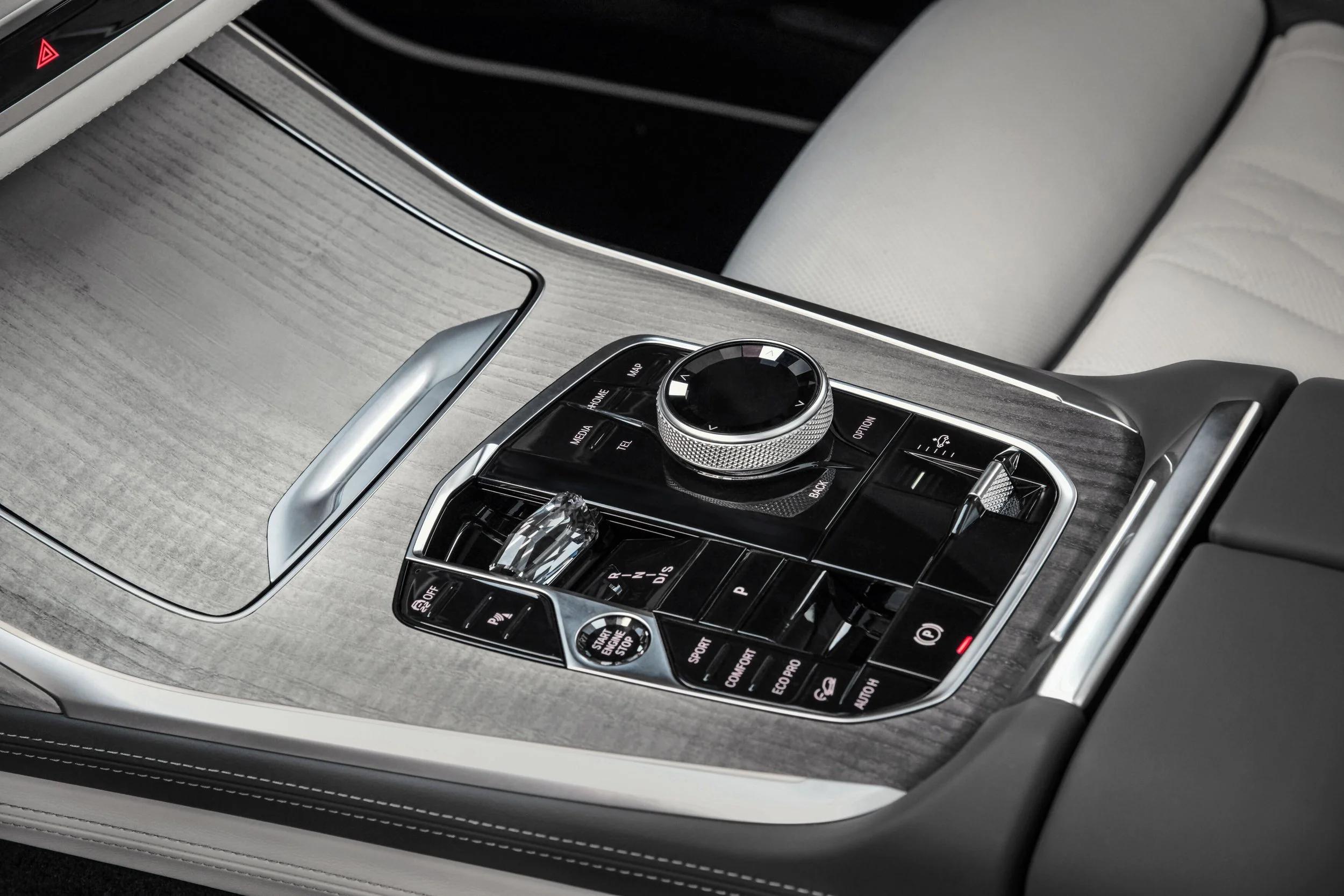
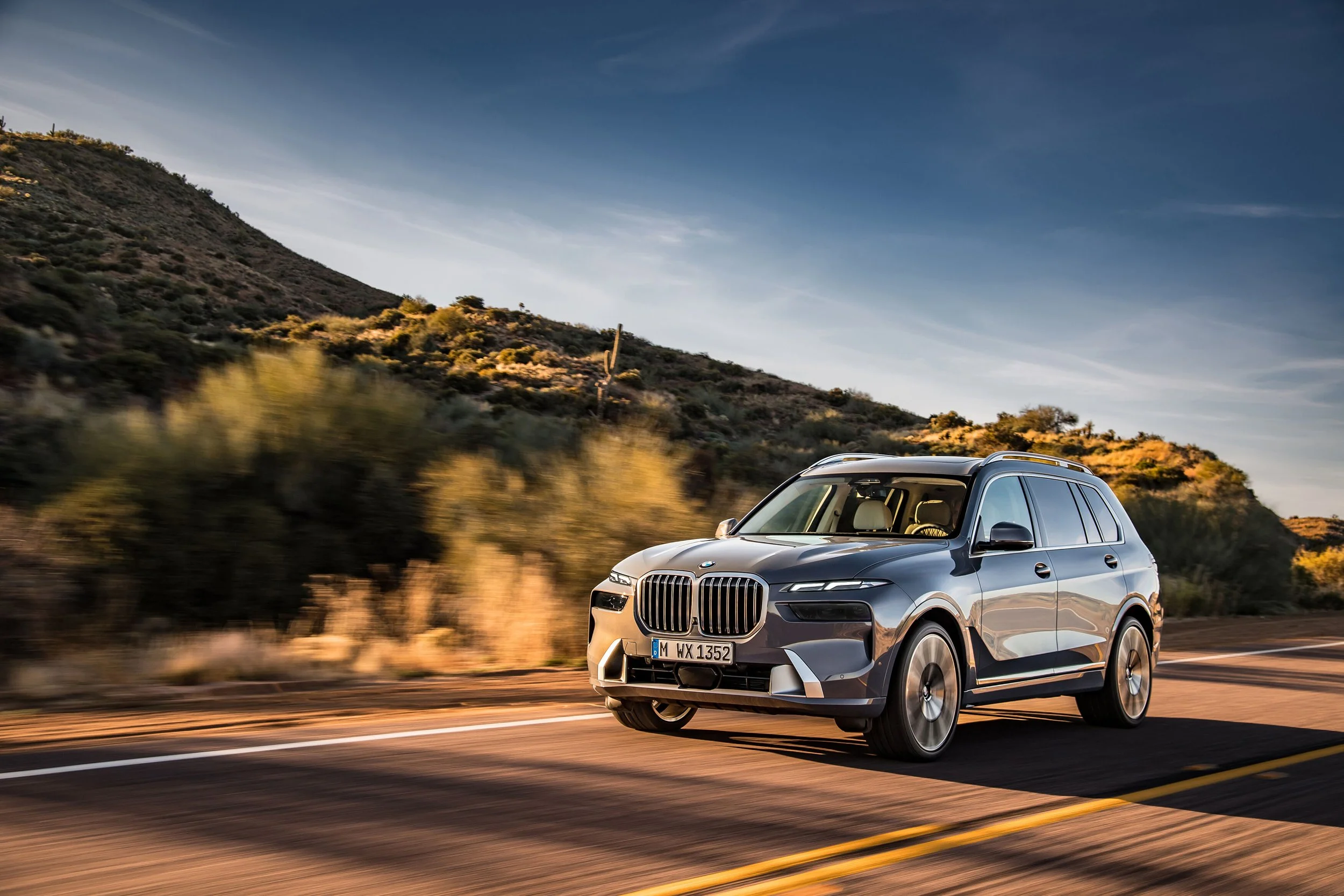
Review: BMW 540d xDrive
Few things make arriving in Melbourne on a cold winter’s morning feel worthwhile. Especially when you’ve just left the sun-soaked streets of Brisbane. But picking up the keys to a 2025 BMW 540d xDrive from BMW Australia? That’ll warm you up real quick.
Parked out the front of BMW Australia’s head office, the 540d looked every bit the modern executive express, understated yet undeniably purposeful. Our test car, finished in Oxide Grey Metallic, wore the M Sport package (fitted as standard on all Australian delivered 540d’s) like a perfectly tailored suit. It’s not shouty, but there’s a quiet confidence in the way it sits. Sharper bumpers, sculpted side skirts, and that wide, low stance give it presence without the need for gimmicks.
The kidney grilles are slimmer and more horizontal than before, flanked by sleek Adaptive LED headlights with a focused, almost predatory gaze. The proportions are spot on too. Long bonnet, short overhangs, and a shoulder line that carries all the way to the muscular rear arches. It's a car that looks just as comfortable pulling up to a client meeting as it would winding through the hills.
It doesn’t scream for attention, but when you walk up to it, key in hand, it has that special something. That quiet sense of occasion. That BMW “rightness” that only a few brands seem to consistently nail.
And then, of course, I opened the door, slid into the cabin, and fired it up...
Slide into the cabin of the 540d, and it immediately sets the tone for what this car is all about - effortless, confident refinement. Hit the start button and you’re greeted not by clatter or grumble, but by the barely-audible hum of BMW’s latest 3.0L straight-six diesel that produces 223kW and 670Nm.
Paired with 48-volt mild-hybrid assistance that recuperates kinetic energy under braking for conversion into electrical energy, it’s buttery-smooth and surprisingly quick off the mark.
Around town, the 540d is a masterclass in composure. The 8-speed ZF gearbox slips through ratios like silk, and the low-end torque (reminder, a monstrous 670Nm) means you’re never caught out when you need to dart into a gap or cruise up an incline. Even in Comfort mode, there's a solid connection between your foot and the drivetrain which is responsive, and never twitchy.
The ride quality is, as expected, genuinely impressive. With adaptive dampers, the car irons out potholes and suburban speed humps with a grace that borders on arrogance. Road noise is minimal. Engine noise? Virtually nonexistent unless you really prod it. It feels, in every sense, like a luxury car first, performance car second. And yet, when you find yourself on an open backroad in rural Victoria...
How does it behave when pushed?
Put it in Sport or Sport Plus and the 540d reveals its other side. The steering weights up, the throttle response sharpens, and suddenly this understated exec sedan starts to show real bite. It’s not trying to be an M5 (which is an entirely different breed of animal that we can’t wait to test out) and it doesn’t need to. The chassis is taut, balanced, and sure-footed thanks to the ridiculously clever xDrive all-wheel drive system. It’s not an edge-of-your-seat kind of sporty, but it’s deeply satisfying.
Coming out of a corner, the diesel torque surges you forward like a wave — muscular and linear. There’s no waiting, no downshift drama, just instant forward motion. Grip is plentiful, especially on the staggered 21-inch setup. It leans more toward grand touring than outright aggression, but make no mistake: the 540d can hustle when it needs to.
Braking performance is solid and progressive. The pedal feel is nicely modulated, not grabby, and inspires confidence even on tighter downhill stretches. In dynamic situations, the car shrinks around you, it feels smaller and lighter than it is, a hallmark of well-engineered German sedans, and one in particular that BMW absolutely nails the brief on, every single time.
Fuel economy? Actually brilliant.
This is where the 540d really flips the script. Despite its size, power, and performance, it returns fuel economy figures that border on wizardry. We saw an average of 5.8–6.2L/100km during a week of mixed driving between city commutes, highway stretches, and spirited weekend/backroad runs. You’re looking at over 1,000km of real-world range from a single tank.
And no, it doesn’t feel like a compromise. In fact, for anyone doing big km or long stints, it makes more sense than a petrol 6 or plug-in hybrid. It’s powerful, refined, and ruthlessly efficient.
Inside the cabin: Modern, clean, very BMW:
The 540d inherits BMW’s latest interior language: curved dual-screen display, flush HVAC controls, and minimalist switchgear and the cabin has a genuinely calming ambience. The materials are top shelf, featuring soft leathers, ambient lighting that subtly wraps around the cabin, and trim finishes that feel expensive, not just flashy. Wireless Apple CarPlay and Android Auto are standard, as is a crystal-clear Bowers & Wilkins audio option that’s worth ticking the box for.
Rear-seat comfort is equally as impressive. There’s excellent legroom for adults, even behind taller drivers, and the outboard seats are nicely contoured and supportive without feeling firm. Headroom is ample despite the sloping roofline, and the rear bench gets its own climate zone, along with air vents, USB-C charging ports, and fold-down armrest with cupholders. Perfect for road trips or the school run.
Kids will have no trouble getting in and out, and the wide-opening doors make fitting a child seat simple thanks to well-positioned ISOFIX points.
Connectivity-wise, the 540d doesn’t miss a beat. As we’ve mentioned previously, Wireless Apple CarPlay and Android Auto are standard, along with a fast pairing and a high-res central touchscreen that’s easy to navigate. There’s also a wireless charging pad up front, dual USB-Cs in the centre console, and more in the rear, meaning everyone stays connected, no matter where they’re sitting.
Boot space comes in at a generous 520 litres, with a wide aperture and low load lip making it easy to throw in luggage, shopping, or a couple of golf bags. The rear seats fold down 40:20:40 for added flexibility, and there’s underfloor storage for cables or smaller items you’d rather not have rolling around.
Servicing & Ownership Costs:
BMW’s Condition-Based Servicing (CBS) system means the car monitors oil, brake pads, fluid levels and usage patterns to alert you when it’s time for a service, rather than sticking to a strict calendar schedule.
In typical usage, you’ll be looking at servicing roughly every 12–18 months or 15,000–20,000km, whichever comes first. BMW’s Service Inclusive Basic plan can be added at purchase, covering 5 years or 80,000km of servicing from around $2,000 AUD at time of writing, which makes it a no-brainer if you’re planning to keep the car long-term.
And thanks to the diesel’s exceptional efficiency, real-world running costs are significantly lower than you’d expect from a premium sedan with this level of performance.
QUICK SPECS:
2025 BMW G60 540d xDrive:
Engine: 3.0L inline 6-cylinder turbo-diesel mild hybrid
Transmission: 8-speed automatic
Power: 223kW @ 4000rpm
Torque: 670Nm @ 1500–2500rpm
0–100km/h: 5.2 seconds
Kerb Weight: 1905kg
Power-to-Weight Ratio: 117kW/tonne
Average Fuel Consumption: 6.5L/100km
CO2 Emissions: 172g/km
Fuel Tank / Range: 60L / approx. 923km
Warranty: 5 years / unlimited kilometres
Service Interval: Condition-based self-diagnosis
Dimensions (L/W/H/Wheelbase): 5060 / 1900 / 1515mm / 2995mm
Cargo Capacity: 520L
Turning Circle: 11.8 metres
Ground Clearance: 154mm
Towing Capacity (Braked / Unbraked): 2000kg / 750kg
ANCAP Safety Rating: 5 stars
Price From (AUD): $134,900
Standard Spec Highlights:
20” M alloy wheels
Metallic paintwork
BMW Iconic Glow illuminated kidney grille surrounds
8-speed Steptronic automatic transmission
Tyre Pressure Monitor
Tyre Repair Kit
Adaptive Suspension Professional (Integral Active Steering, Adaptive Suspension)
Alarm System
Automatic tailgate
Comfort Access
M Sport Package
BMW Iconic Glow Exterior Package
M Sport Brake, Dark Blue Metallic
Interior Trim, Carbon Fibre and high-gloss silver threads, Dark Silver M accents
Travel & Comfort System
Interior Camera
Ambient light
Panorama Glass Roof (non-opening)
Through loading system
Sport seats
Lumbar support - front
Seat heating - front
Driving Assistant Professional
Parking Assistant Professional
Automatic Air Conditioning - 2-Zone
Adaptive LED headlights
Intelligent Emergency Call
TeleServices
BMW ConnectedDrive Services
Connected Package Professional
Bowers & Wilkins Surround Sound (655-watt,18 speakers)
Wireless Charging Tray
Personal eSim
BMW Live Cockpit Professional
Natural Interaction
DAB+ Radio
M Leather Steering Wheel
BMW Individual Leather ‘Merino’ Upholstery
5-year BMW Warranty
The Verdict:
The 2025 BMW 540d xDrive might just be the ultimate all-rounder in the 5 Series lineup. It’s not the flashiest, nor the most headline-grabbing variant, but for those who crave long-legged range, genuine pace, and silent luxury, it’s an absolute gem.
While the world moves toward EVs and petrol-hybrid blends, this diesel holds its own as a compelling option. It’s the kind of car that doesn’t need to shout. Because it knows exactly what it’s capable of.
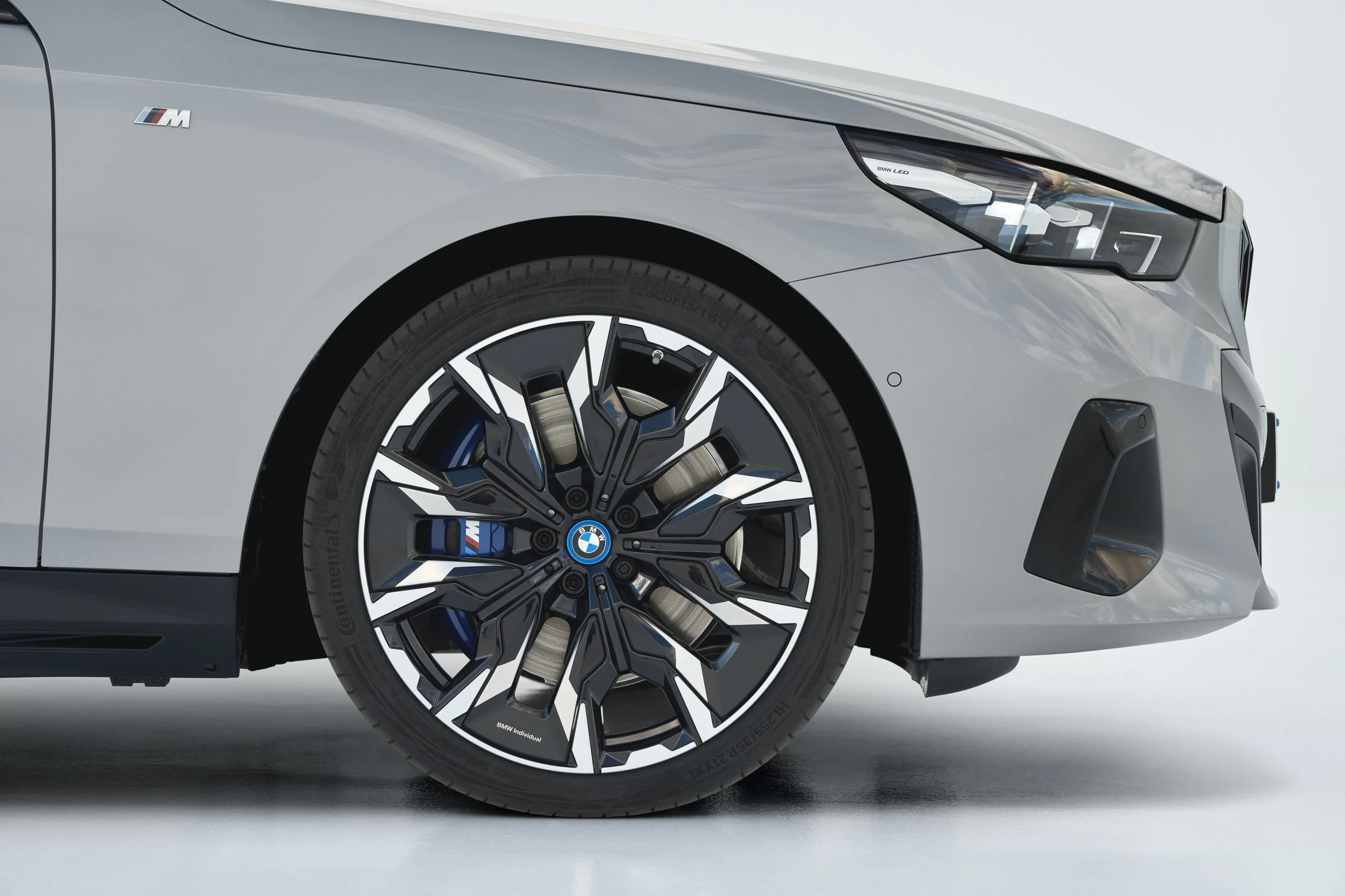

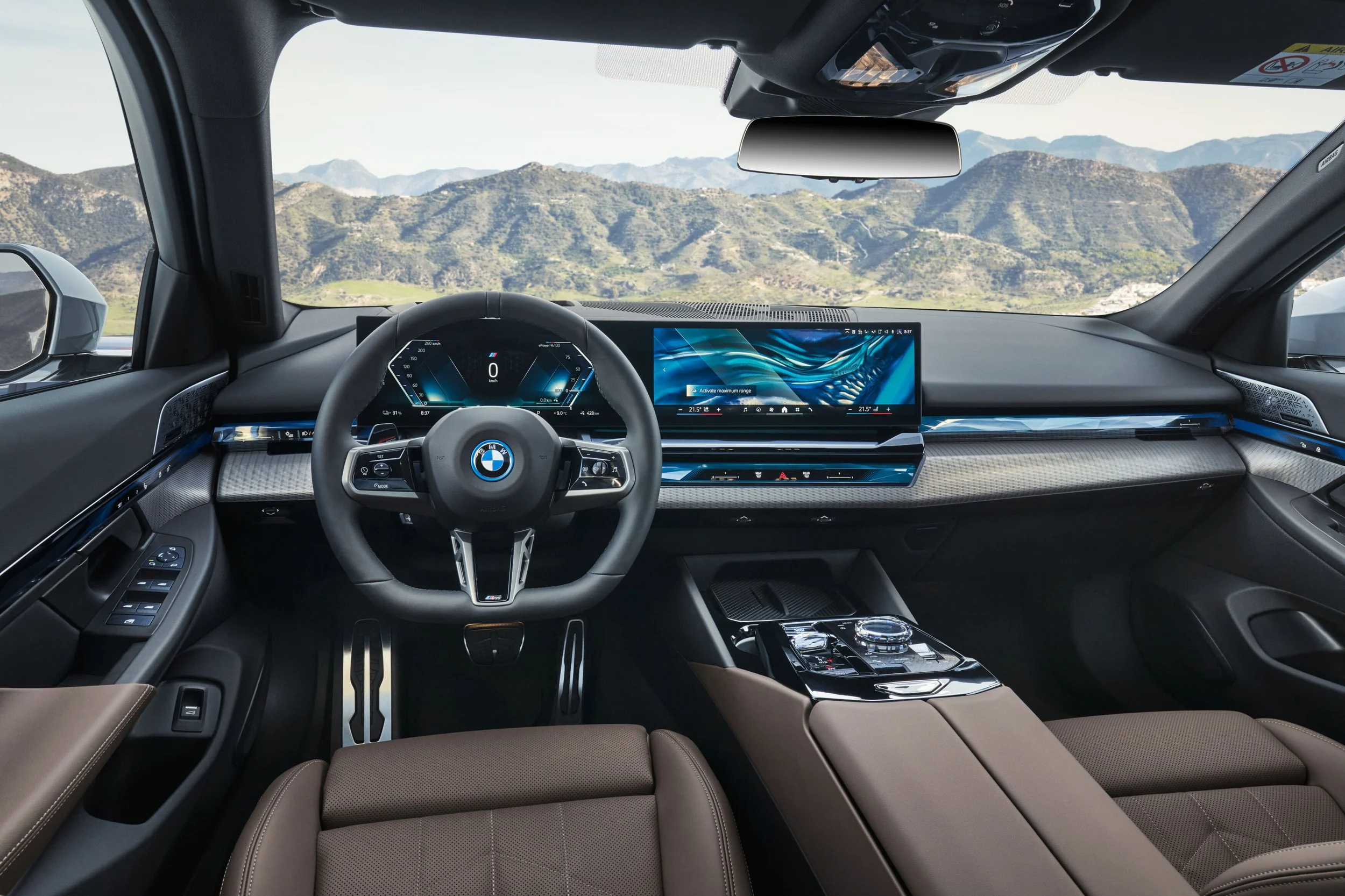
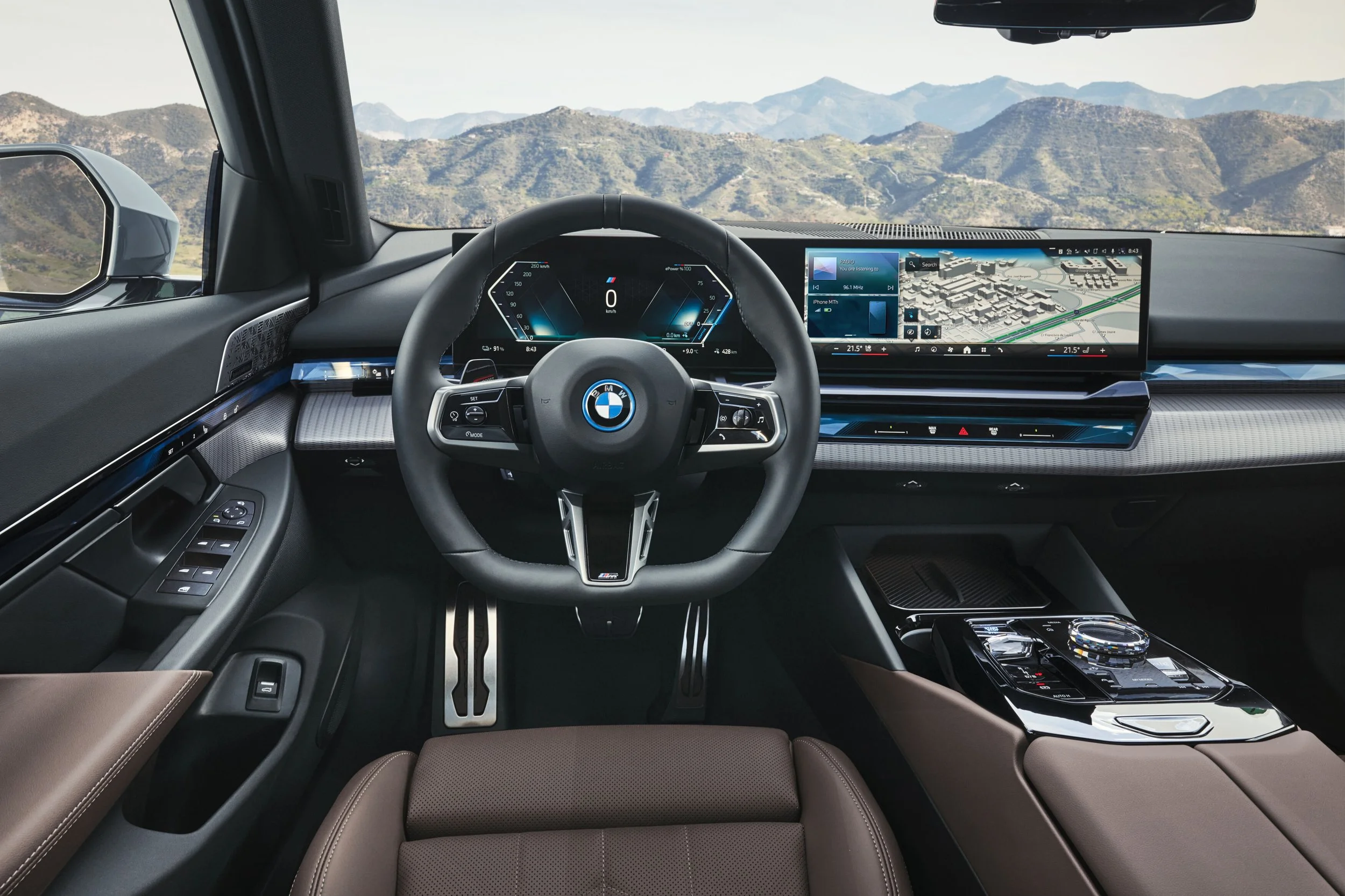
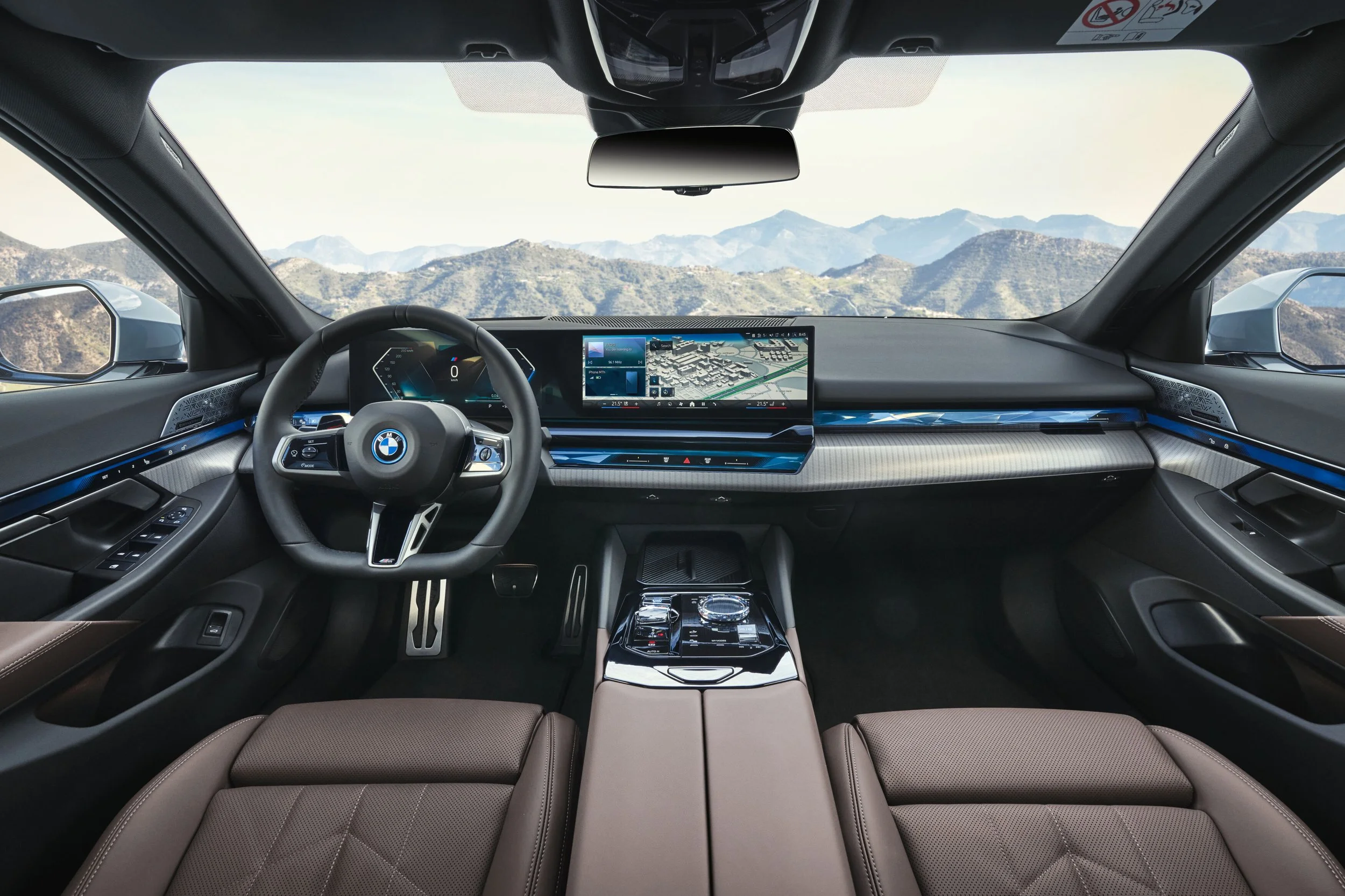
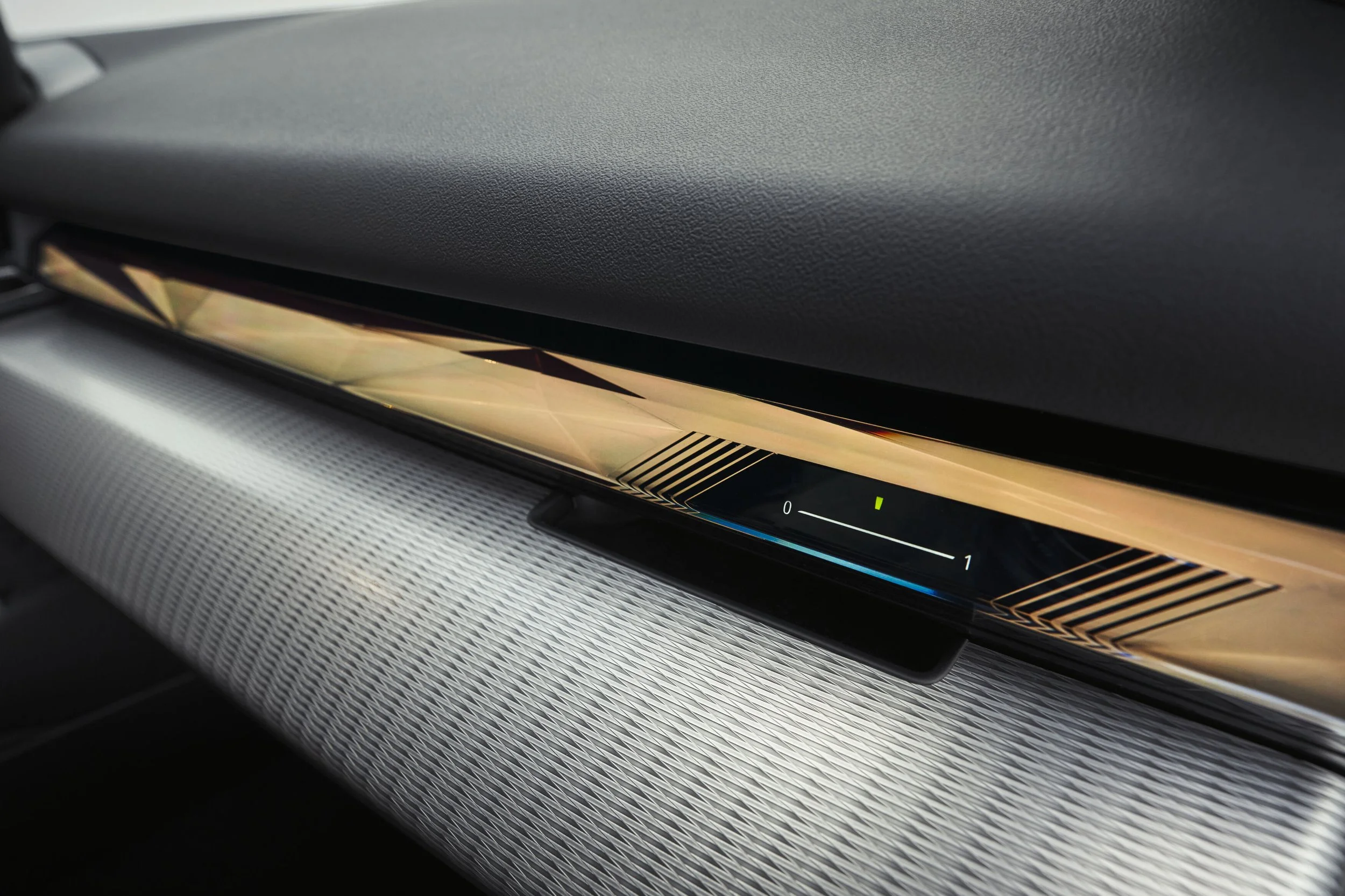
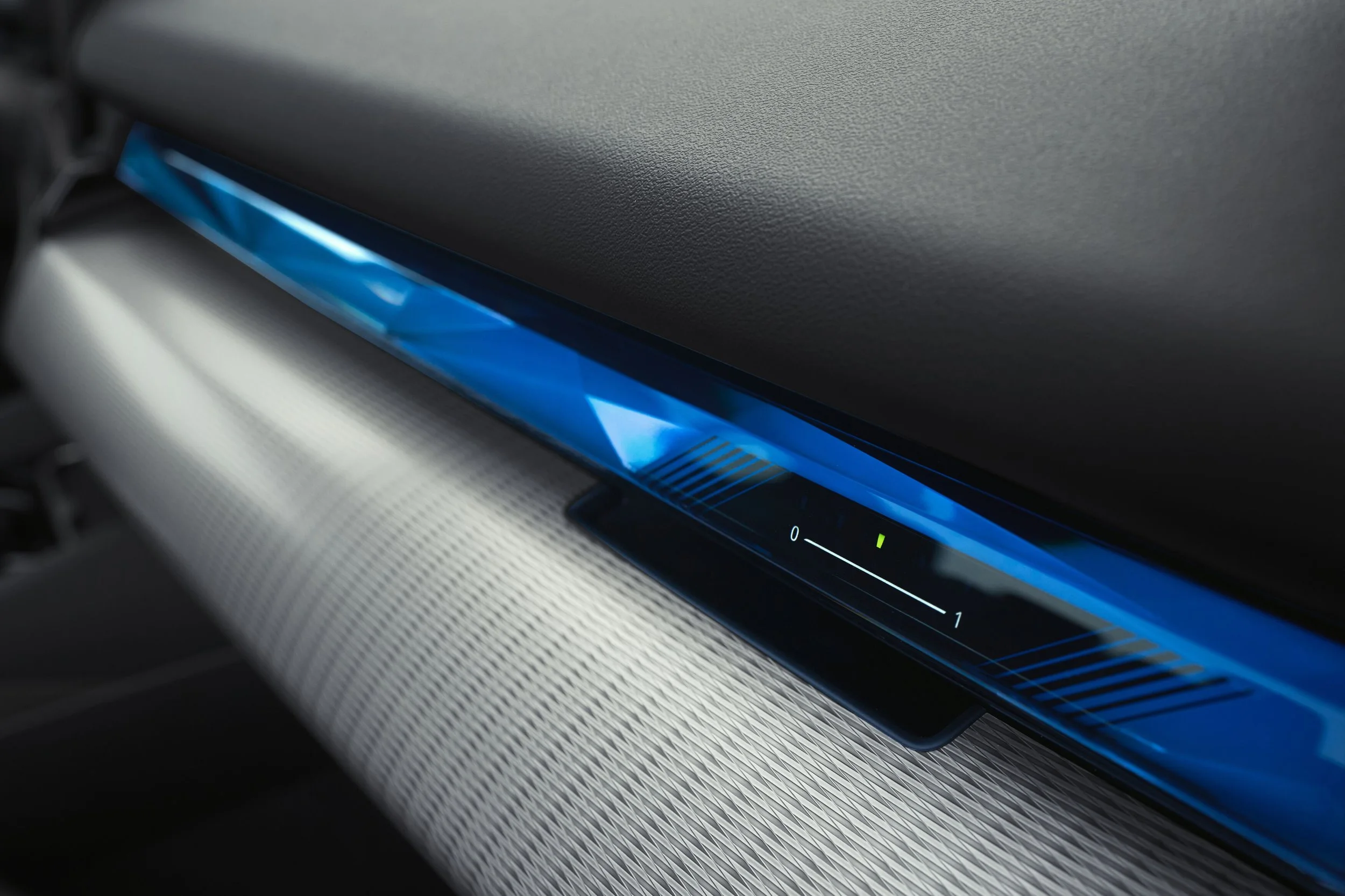
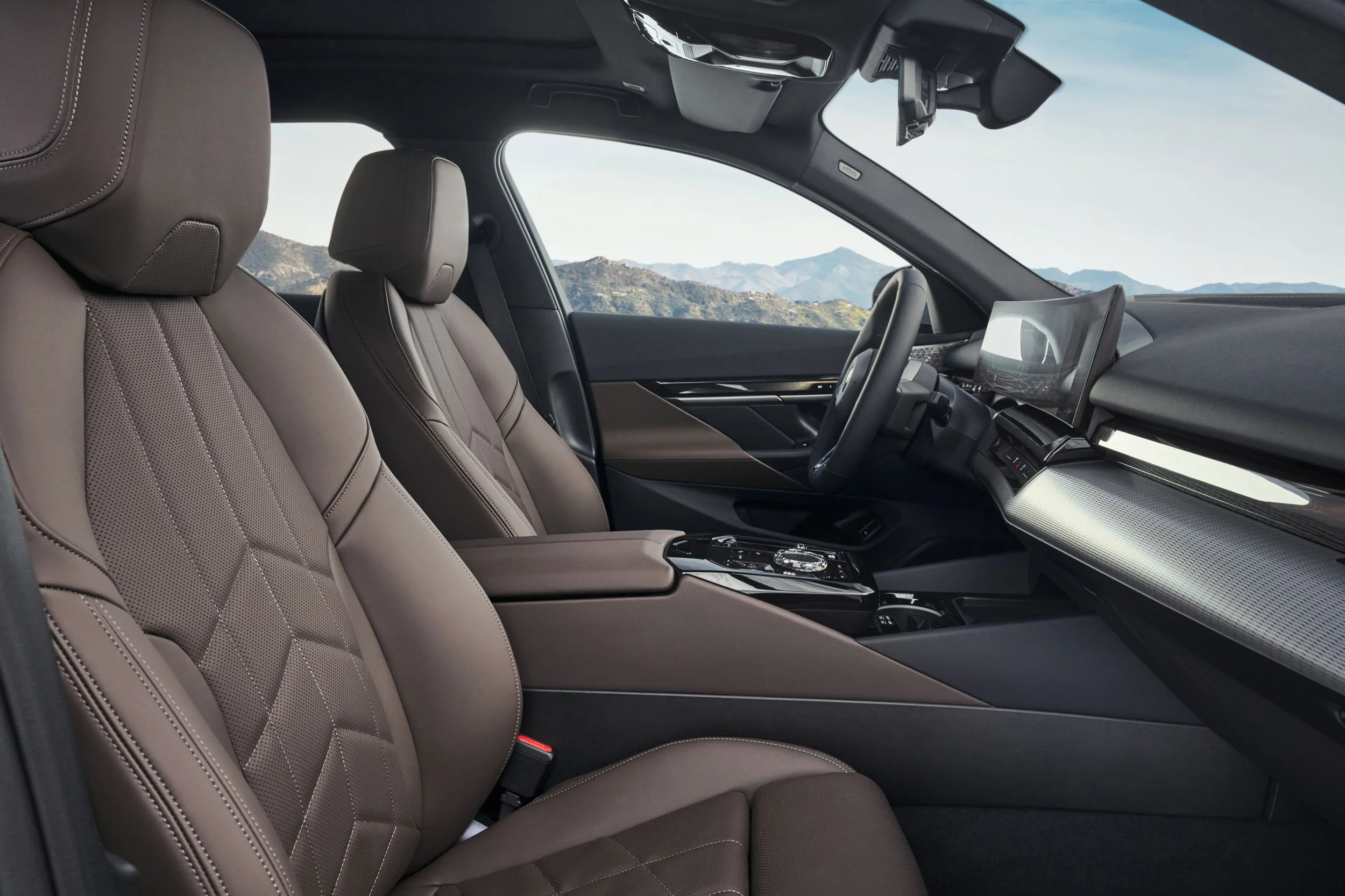

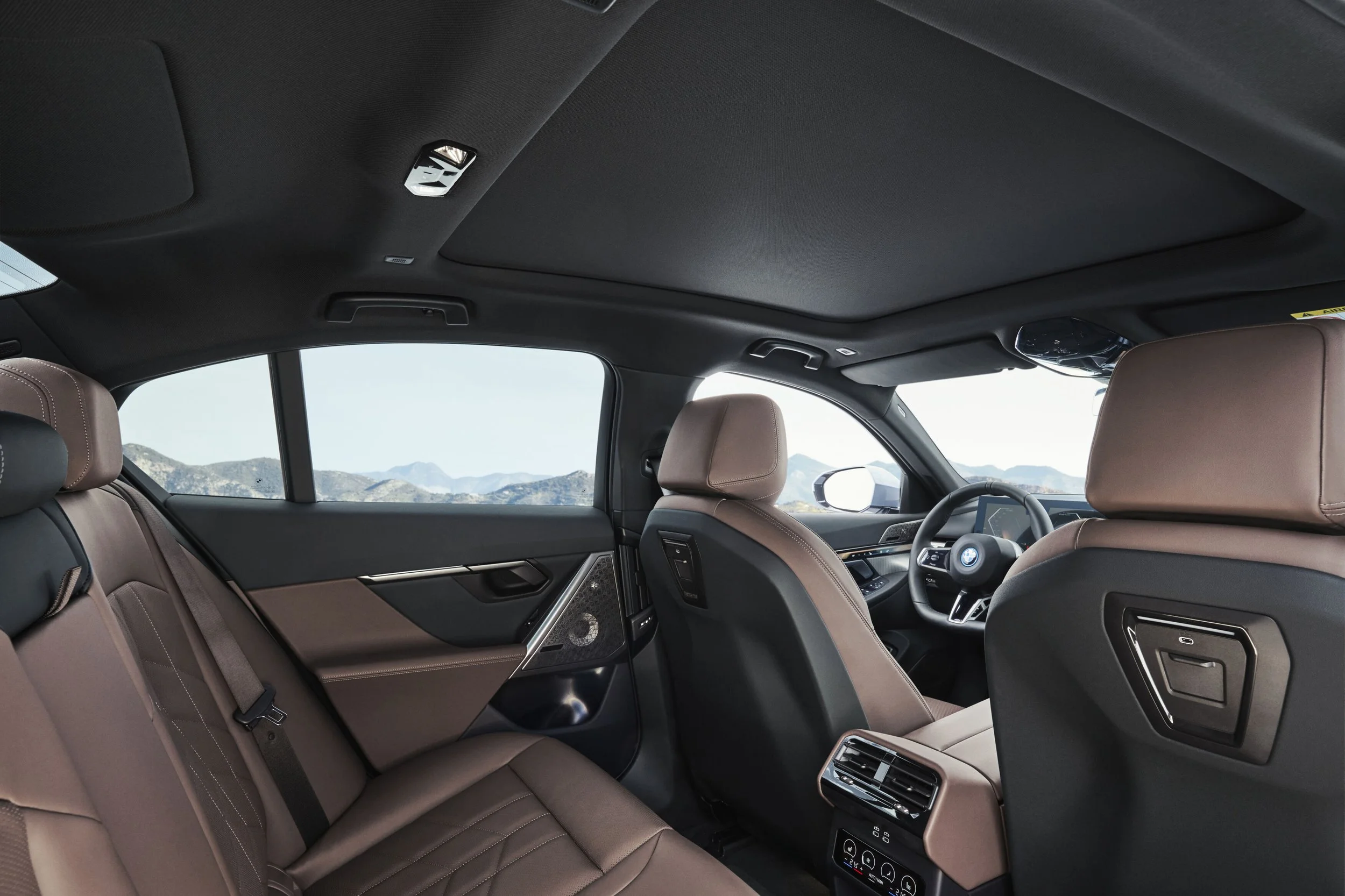
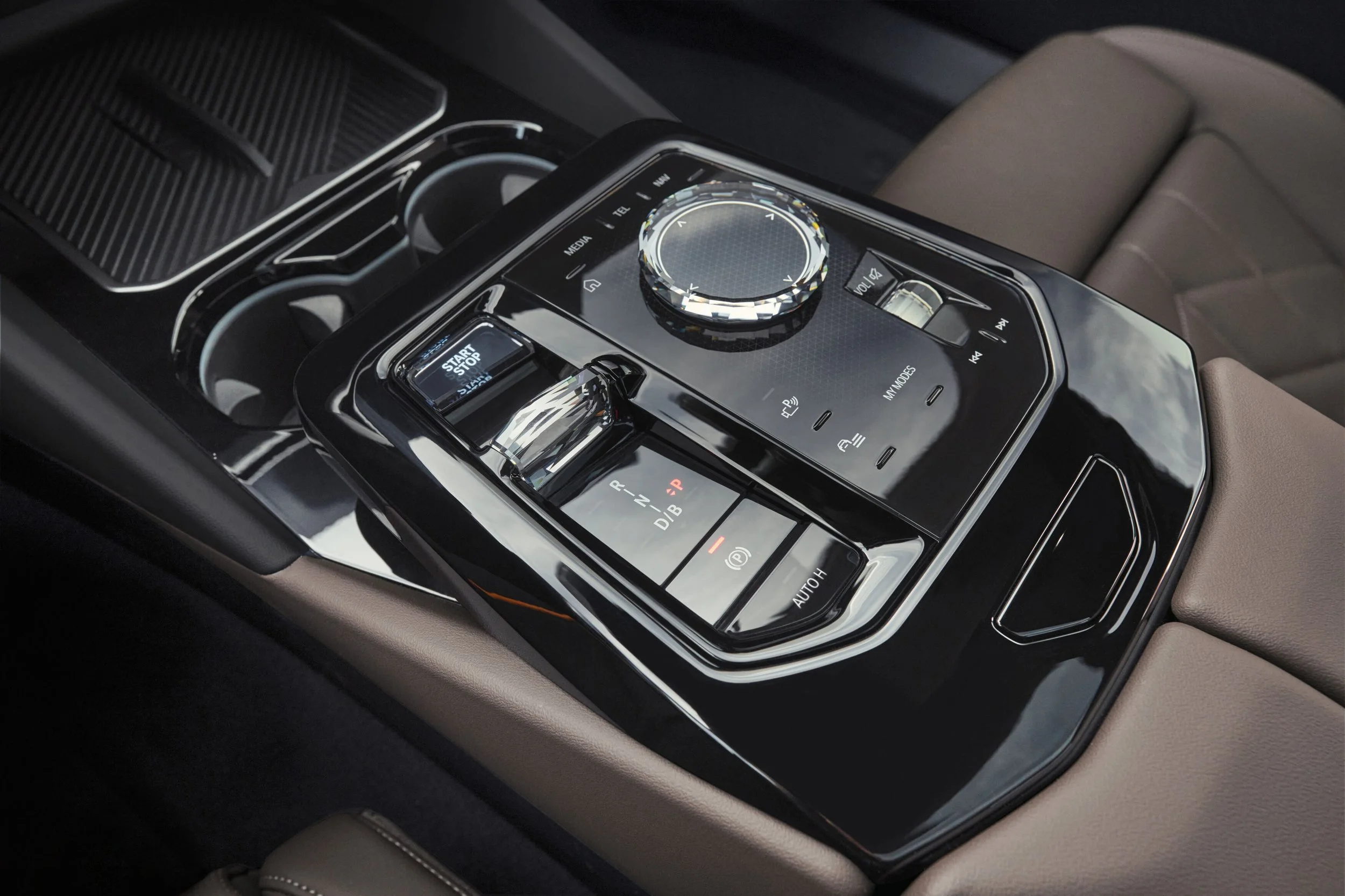
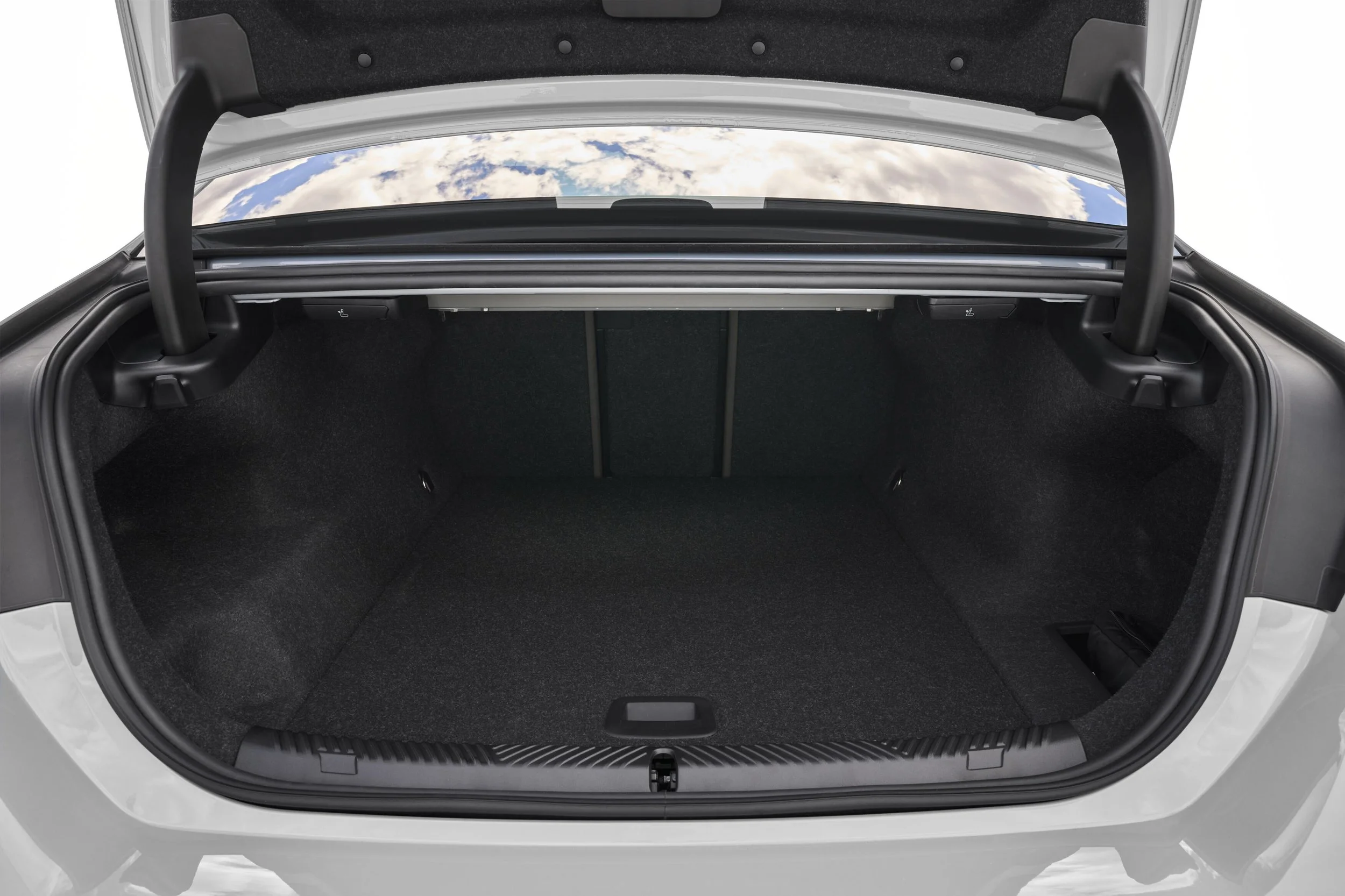
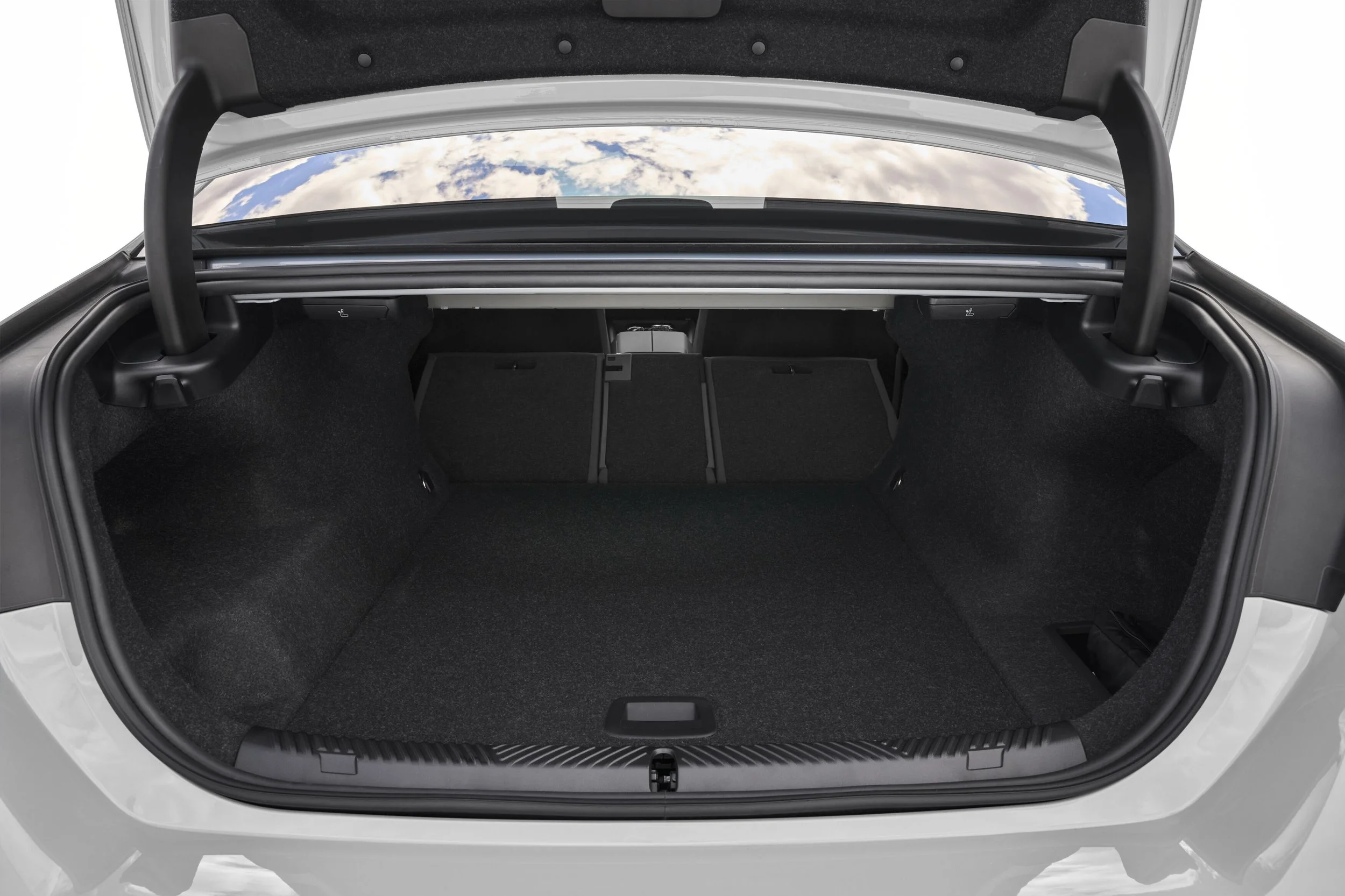
Review: Hyundai i30 N DCT
Hot hatches are becoming an endangered species in today’s SUV-saturated world, but clearly someone forgot to tell Hyundai. Which is a good thing. The i30 N is still here, still angry, and still revving to remind us what driving joy used to feel like before everything became automated and anaesthetised. The 2025 update keeps the fire alive with subtle refinements, a touch more polish, and that all-important 8-speed DCT.
The Drive:
Put simply, the 2025 Hyundai i30 N is a riot. From the moment you thumb the start button, there’s a rasp and a bark from the active exhaust that lets you know it hasn’t gone soft. Even in its most civilised setting, there’s an underlying sense of tension, like it’s just waiting for an excuse to go absolutely feral.
Around town, the DCT is surprisingly docile. It’ll potter about with all the manners of a commuter hatch when left in Normal mode. The steering is light, the ride is firm but tolerable (especially on the updated dampers), and the shifts are buttery smooth. This is a hot hatch you can daily. But it's the kind of daily that winks at you every time you enter a tunnel.
But tap the "N" button, and the polite commuter vanishes. Throttle response sharpens instantly. The steering weights up with meaty resistance. Exhaust valves crack wide open. The shifts become lightning fast and delightfully aggressive, with every upshift delivered with a shotgun crack and every downshift spat out like a rally car on overrun.
Hyundai’s e-LSD continues to be the party trick in the twisty stuff. Point it into a corner and the front end just bites. Hard. Torque is intelligently shuffled side to side, letting you get on the power earlier and harder than you think you should. There’s virtually no torque steer either, just pure grip and grin-inducing rotation.
There’s still a playful edge to the chassis, too. Lift mid-corner and the rear gets light, but never unruly. It’s chuckable, forgiving, and properly communicative, something too many new performance cars seem to have forgotten how to be.
The Powertrain:
The turbocharged 2.0-litre four-cylinder hasn’t changed much, and that’s a good thing. It still pumps out 206kW (280PS) and 392Nm, and feels strong right through the rev range. It’s a muscular unit with just the right amount of lag to keep things interesting.
The DCT is an absolute gem. Quick, intuitive, and almost always in the right gear. You can take manual control via the paddles, but honestly, it reads your mind so well you rarely feel the need. There’s also a rev-matching feature and launch control that lets you catapult off the line with hilarious effectiveness. Hyundai claims 0-100km/h in 5.4 seconds, and it feels every bit that quick.
Hyundai’s N Grin Shift overboost mode also gives you 20 seconds of full-send aggression - perfect for overtakes or giving your passenger an existential crisis.
Interior and Tech:
Inside, the i30 N balances sport and everyday usability perfectly. The seats are some of the best in the segment - supportive, nicely bolstered, and finished in Alcantara with N badging. The new 10.25-inch infotainment system is slick and responsive, and comes with all the right goodies: Apple CarPlay, Android Auto, N-specific track timers, G-force meters, and lap telemetry.
There’s also:
USB-C and USB-A ports up front, so you’re covered no matter what cable you’re carrying.
A wireless charging pad, neatly tucked under the centre stack, which keeps your phone in place even during… spirited driving.
Dual-zone climate control, because even hot hatch hooligans appreciate cabin comfort.
A surprisingly solid stereo, if you're the type to soundtrack your downshifts.
Rear ISOFIX mounting points, making it one of the few performance cars where you can clip in a baby seat and crack the exhaust open on the way to daycare.
The digital instrument cluster morphs depending on the drive mode, with a particularly angry ‘N Mode’ that looks like it was pulled straight out of a racing sim. It’s all quite over-the-top, but gloriously so.
Boot space? Rear seats? Yes, they exist, and they’re usable. This is still a practical five-door hatch at its core, but one that makes every drive to the shops feel like a qualifying lap. Boot Space comes in at 381 liters with the rear seats up, and 1,287 liters with the rear seats folded down.
What it Gets Over the Standard i30:
206kW 2.0L turbo engine
8-speed wet dual-clutch transmission
Electronically controlled limited-slip diff
Adaptive suspension with multiple drive modes
Active variable exhaust
N performance seats with Alcantara trim
19-inch lightweight alloys on Pirelli P-Zeros
Larger brakes, reinforced chassis
Track-ready drive modes (incl. launch control, G-meters)
SPECS:
Engine - 2.0-litre turbocharged petrol 4-cylinder.
Power - 206kW
Torque - 392Nm
Transmission - 8-speed dual-clutch automatic (DCT)
Driven wheels - Front-wheel drive
Weight - 1541kg (kerb)
0-100km/h (claimed) - 5.3 seconds
Fuel economy (claimed) - 8.5L/100km
Fuel economy (as tested) - 12.0L/100km
Fuel tank capacity - 50L
Fuel requirement - 95 octane premium unleaded
CO2 emissions - 197g/km
Emissions standard - Euro 5
Braked tow capacity - 1600kg
Priced From: $50,000 +ORC’s
Ownership – Value Without Compromise:
Hyundai’s capped-price servicing scheme makes ownership painless: roughly $377/year over 5 years, and that includes non-competitive track-day cover under the factory 5-year unlimited km warranty. Read that again: track-day warranty.
Fuel economy is claimed at 8.5L/100km combined, though if you drive it the way it begs to be driven, expect closer to 11–12L. Worth every drop.
Verdict:
The 2025 Hyundai i30 N DCT isn’t trying to be a Golf GTI or a Civic Type R. It’s rawer than the Golf, and more fun at lower speeds than the Honda. It’s the kind of car that wants you to drive. To push buttons, flick paddles, and giggle your way through roundabouts like a delinquent with a licence.
Sure, the ride can be firm. And no, it doesn’t have the premium interior of some German rivals. But for the money, nothing else offers this much fun, this much tech, and this much real-world performance in such a usable package.
The i30 N is still the people’s champion of hot hatches. And now, with the DCT, it’s sharper, quicker, and more accessible than ever.
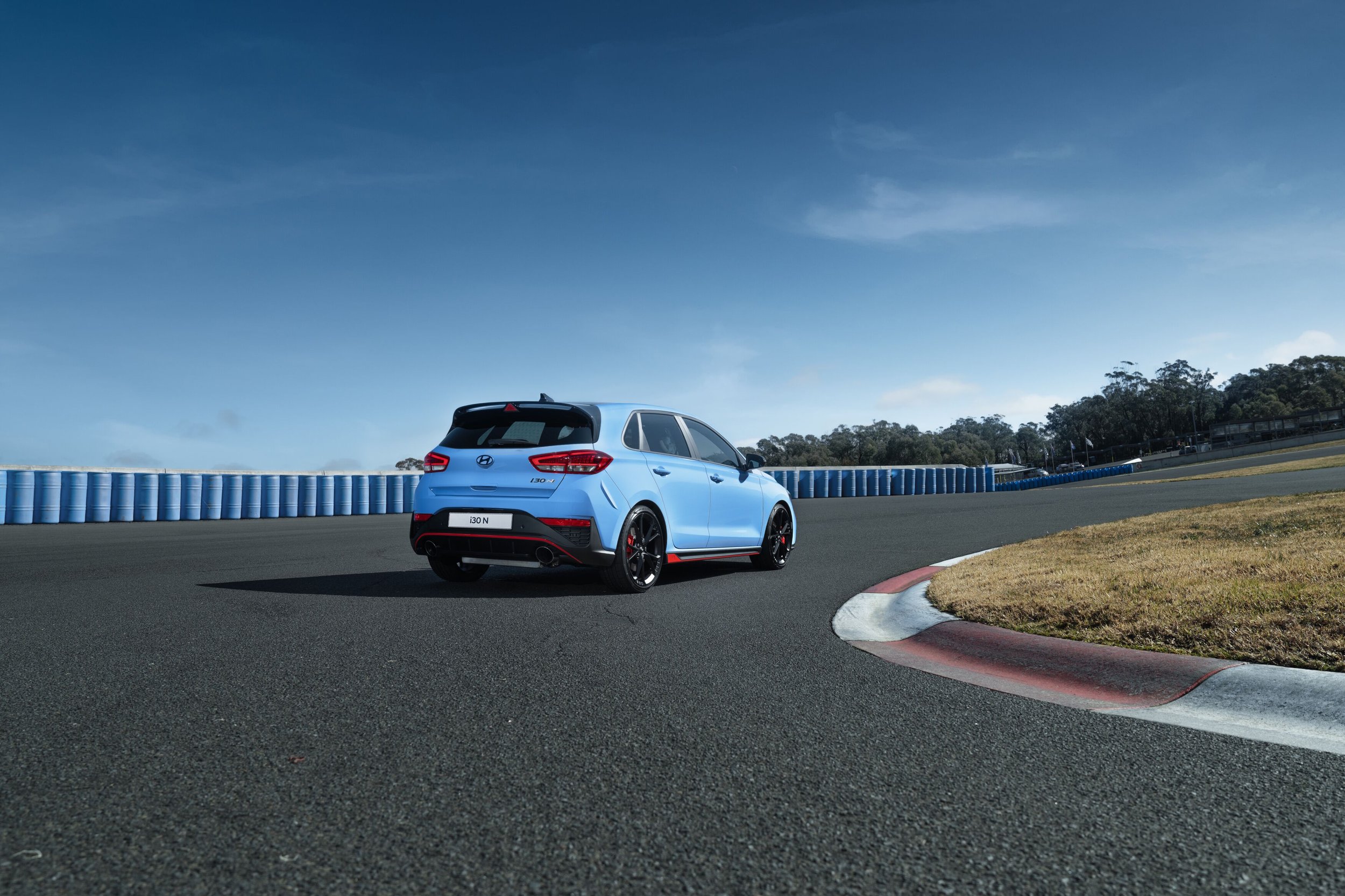
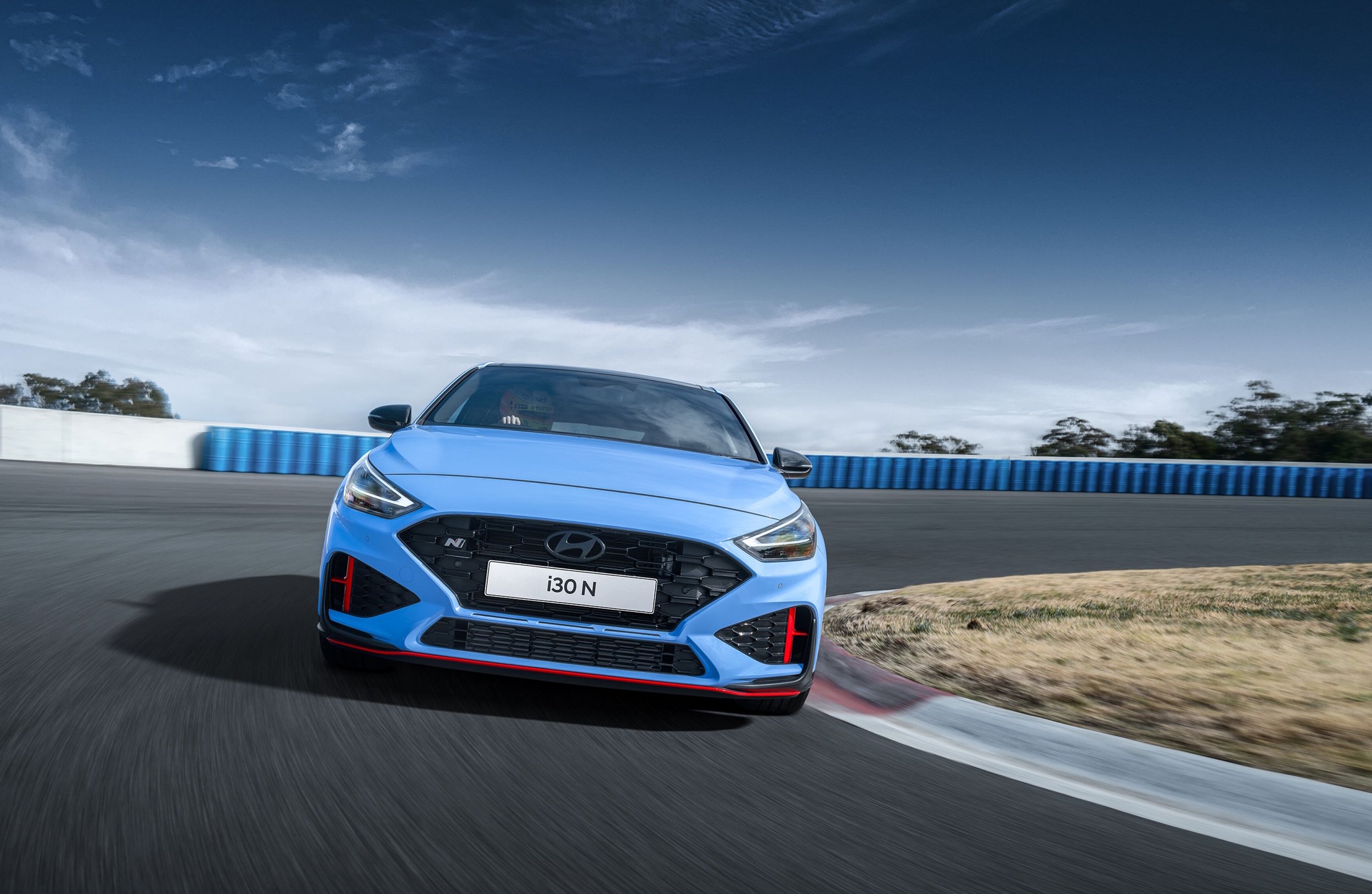
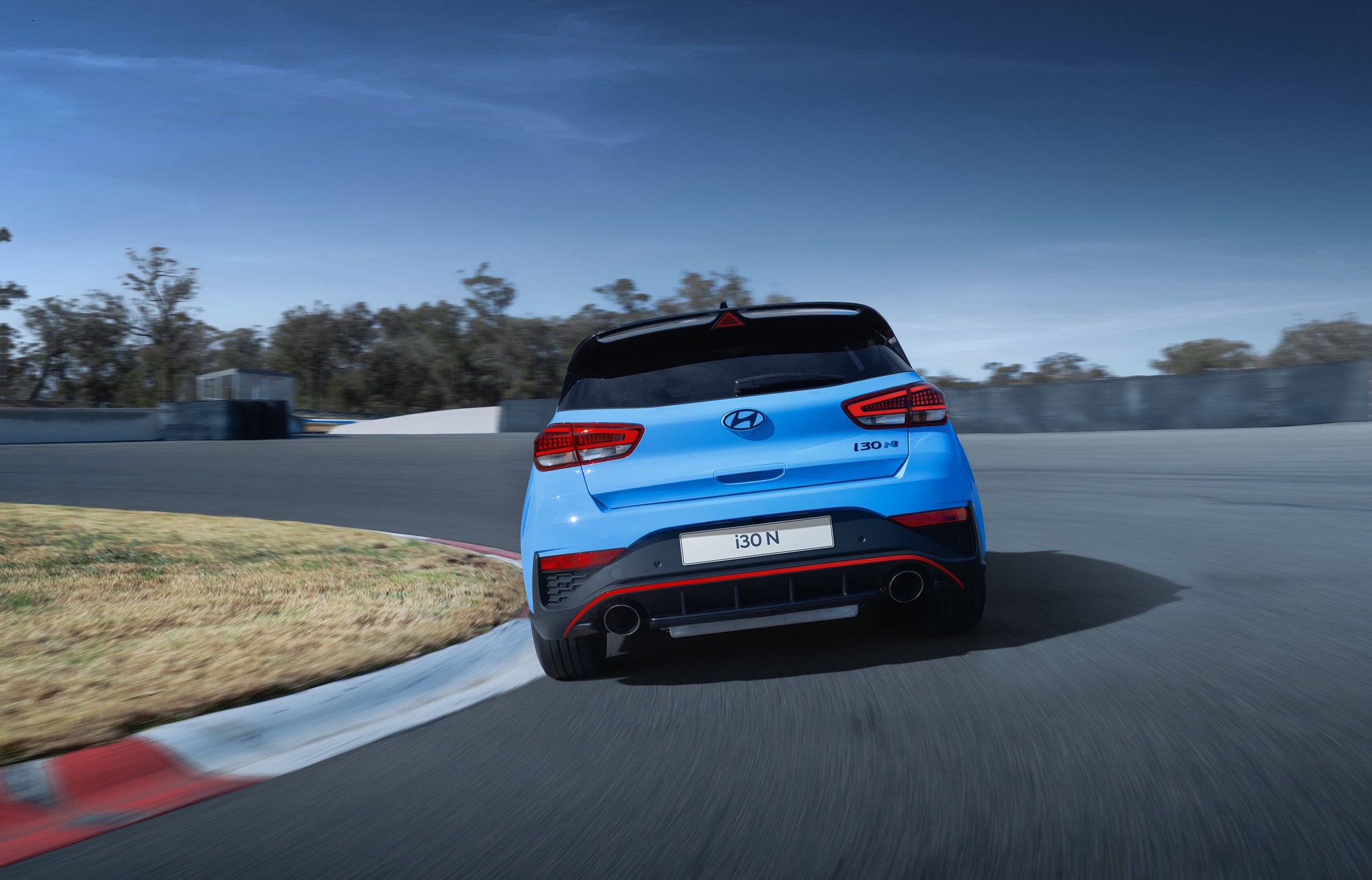
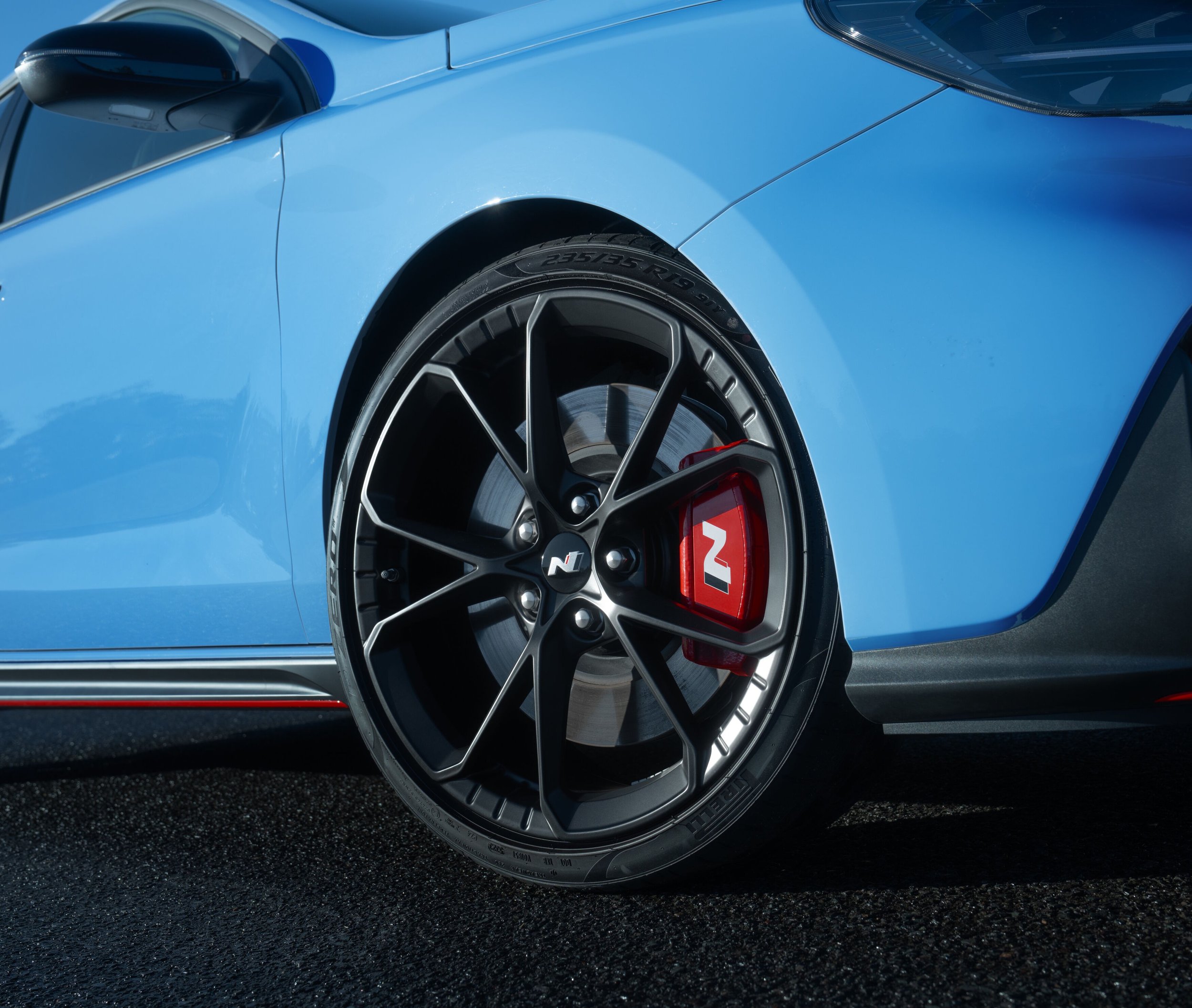
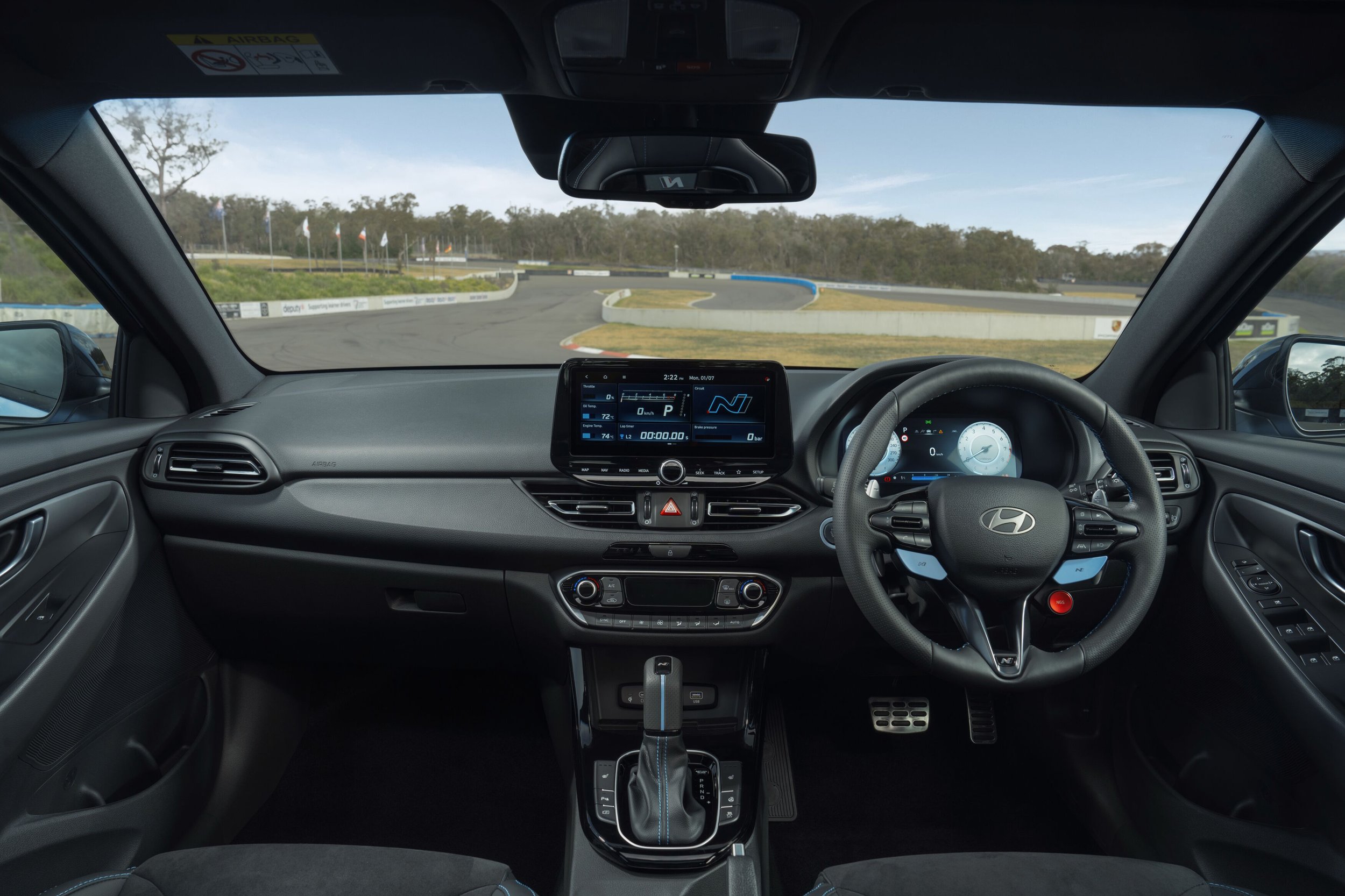
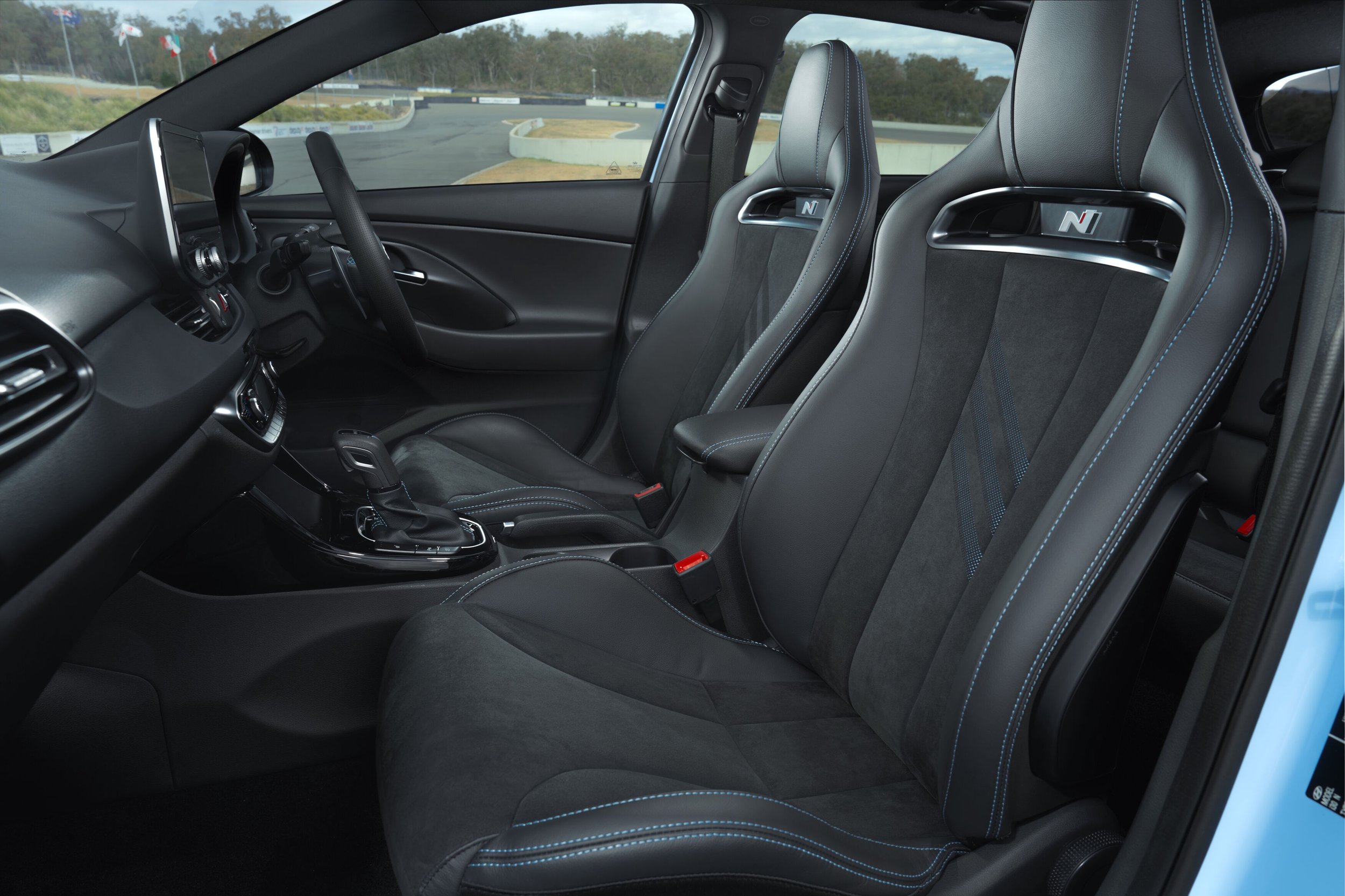

Review: Nissan Patrol Warrior
There’s something deeply satisfying about a vehicle that feels completely unbothered by modern trends. The 2025 Nissan Patrol Warrior isn’t here for hybrid badges or silent EV cruising. It’s here to roar down a dirt track, tow a house, and intimidate the fast lane. All the while cradling you in leather and, finally, giving you an infotainment system that doesn’t feel like it came from the iPod Classic era. Cheers, Nissan!
If you’re after subtle, keep walking. This thing wears its intent like a bullbar to the chest.
That Engine: Long Live the V8
Under the bonnet remains the heart of the beast, Nissan’s 5.6-litre naturally aspirated V8, pushing out 298kW and 560Nm of torque. That sonorous soundtrack remains untouched, unfiltered, and utterly glorious. It's not loud for theatre. It's loud because it means it. And we love it!
Slam the throttle and the Warrior lunges forward with a snarl, the 7-speed auto grabbing gears with determined smoothness. It’s not fast in a 0–100 brag-sheet sense, but on the open road, with your right foot down and a trailer hooked up behind, it feels utterly unstoppable.
In a world where turbocharged sixes and four-cylinder hybrids are taking over, the Patrol Warrior remains a V8 dinosaur with purpose, and we’re not complaining.
On the Road: Tuned for Australia, Built for Everything
Walkinshaw’s fingerprints are all over the Warrior’s tuning, and it shows. The suspension is lifted by 50mm, with upgraded springs and dampers tuned specifically for Australian conditions. Corrugations? It glides. Uneven urban roundabouts? Ironed flat.
The Warrior swaps the standard Patrol’s chrome bling for matte-black toughness, sits on 18-inch alloys wrapped in Yokohama Geolandar all-terrains, and carries a full underbody bash plate setup. It's not just for show either, it feels confident on loose surfaces and gravel, shrugging off potholes and undulations with a calm that belies its size.
Steering is light, maybe a bit too light for some, but makes low-speed manoeuvring surprisingly easy for a rig this big. Visibility? Panoramic. You feel tall, wide, and in charge. Because you are.
Updated Cabin: Finally, the Screens We Deserve
Okay, let’s address the elephant in the cabin — the infotainment finally got the update it desperately needed.
Gone is the outdated dual-screen setup. In its place: a modern, crisp 12.3-inch central touchscreen with wireless Apple CarPlay and Android Auto, paired with a 7-inch digital driver display that actually feels relevant in 2025.
The interface is slick, responsive, and integrates seamlessly with your phone. There’s also a premium 13-speaker Bose audio system, wireless charging, and more USB-C ports than you'll ever need on a bush trip. It’s not cutting-edge luxury, but it’s exactly what the Patrol needed to stay competitive in the upper large-SUV segment.
Interior Comfort and Practicality
Inside, the Patrol Warrior offers an old-school kind of luxury: big leather seats, real buttons, and a commanding driving position. You get tri-zone climate control, and oodles of space — both in the cabin and the cargo area. Sadly, due to the Warrior being based off the Ti model, one feature we would have liked to have seen, were some heated and cooled seats - if you want those as a necessity, you need to grab the top spec Ti-L model.
Third-row passengers won’t feel like afterthoughts, and with the seats folded flat, the Patrol becomes a genuine long-haul adventure rig, capable of swallowing gear, bikes, eskies, recovery tracks, you name it.
Towing and Off-Road Capability
Let’s be honest — this is where the Warrior earns its stripes.
Towing capacity: 3,500kg braked
Ground clearance: 275mm
Approach angle: 40 degrees
Departure angle: 23.3 degrees
Rear diff lock: Standard
Tow bar and wiring: Factory fitted
Whether you’re pulling a caravan through the Red Centre or climbing out of a muddy trail in the High Country, the Warrior has the grunt, clearance, and protection to back you up.
Safety Tech: It’s All There
The Warrior comes with a comprehensive safety suite, including:
Intelligent Emergency Braking
Forward Collision Warning
Blind Spot Monitoring
Rear Cross Traffic Alert
Lane Departure Warning
Intelligent Cruise Control
There’s also a 360-degree camera system, which is crucial when navigating tight trails or reverse-parking this leviathan at Woolies.
Fuel Economy: Bring Your Wallet
No surprise here, the Warrior is thirsty. V8 thirsty. Official claim sits around 14.4L/100km, but real-world figures often push into the 16–17L/100km range if you’re doing mixed driving. Add towing or off-road use, and you’ll be topping up often.
But again, you don’t buy a Patrol Warrior to save on fuel. You buy it because it’ll get you, and whatever you’re pulling, just about anywhere, in absolute comfort.
Final Word: The Last of a Legend, Now Sharpened
The 2025 Nissan Patrol Warrior is a fistful of old-school muscle, rugged refinement, and real-world off-road ability, now with a tech update it desperately needed. It’s loud, proud, and designed unapologetically for the Australian market.
Yes, it’s thirsty. Yes, it’s massive. But it’s also one of the last naturally aspirated V8 4x4’s you can buy off the showroom floor and it now finally has the interior to match its grunt and presence.
If you’ve ever said “they don’t make ‘em like they used to” then the Patrol Warrior is your last stand.





















Review: Nissan Nismo Z
There’s something beautifully out of sync about the 2025 Nissan Z Nismo. In a world sprinting toward silence and software, this car throws on a pair of driving gloves, growls from idle, and drags you back to the seat of your pants. Literally and emotionally.
It’s not here to out-tech a Porsche. It’s not chasing lap records. It’s here to remind you what it feels like to drive.
Start-up: The Mechanical Greeting
Press the red starter button and the twin-turbo 3.0-litre V6 clears its throat with a bark that is louder, meaner, and more mechanical than the standard Z. No fake audio trickery. No polite EV whirr. Just proper exhaust acoustics, raw through the titanium-tipped pipes and sharper thanks to a revised ECU tune.
At idle, it pulses like it’s got somewhere to be. The cabin, decked out in Alcantara and red-accented stitching, tightens around you like a tailored suit. This isn’t comfort-first. It’s cockpit-first.
On the Road: Firm, Focused, and Unfiltered
The Nismo Z rides firmer than the standard Z, that’s no question. Hit a rough section of bitumen and you'll feel it in your spine. But hey, that’s the price of precision.
The steering is heavier, more deliberate. It doesn’t snap to centre. It loads up. There’s a weight to the wheel that reminds you of older GT cars, where feedback wasn’t filtered by sensors and servos.
Turn in, and the front end digs with intent. Nissan’s chassis tweaks that include bracing, stiffer bushings, and some reworked dampers make the Nismo feel planted but alert. It rotates with throttle input in a way that feels familiar to anyone who’s driven a 370Z Nismo… but with actual pace to match the attitude.
And that’s where this car really separates itself.
Throttle Response and Grit
At full tilt, the revised twin-turbo V6 now delivers 309kW and 520Nm (as opposed to the regular Z’s 298kW and 475Nm). Doesn’t exactly sound like headline-grabbing numbers, until you actually pin it.
There’s a muscular swell from low rpm, then a surge at 3,500 that makes the rear-end twitch if you're not dialled in. The 9-speed auto, with its Nismo-specific tuning, slams shifts home like a fast dual-clutch without feeling synthetic. Pop it into manual mode and you’ll find yourself playing with the paddles just to hear that deep, metallic roar between gears.
Traction is strong but not overwhelming. Push past the grip and the car lets go with a progressive slide, not a snap. Here is where we take a moment to say thank you to Nissan’s engineers, who didn’t over-digitise the experience. They refined the chaos, not removed it.
Brakes, Body Control, and Balance
Nismo-spec brakes are ferocious. Pedal feel is immediate, with a solid, confidence-inspiring bite that lets you dive deeper into corners than expected. Body roll is minimal, but not erased, almost just enough lean to tell you what the car’s doing beneath you. It’s that balance of honesty and composure that makes the Nismo feel more alive than many of its more powerful peers.
And when you back off, it settles. Quietly. No hiss, no drama. Just you, the car, and that feeling that driving is supposed to mean something.
Safety Tech: Subtle but Present
True to its old-school vibe, the Z Nismo doesn’t overwhelm you with intrusive safety systems. But it’s not barebones either. You get:
Forward Collision Warning with Auto Emergency Braking
Blind Spot Monitoring
Lane Departure Warning
Rear Cross Traffic Alert
Adaptive Cruise Control
There are no nanny-state alerts constantly beeping at you mid-corner. Just enough to keep things sensible when you're not chasing apexes.
Fuel Economy: Not Its Party Trick
Let’s be honest. Efficiency isn’t what you buy a Nismo for. Nissan claims 10.8L/100km combined, but if you’re using the throttle the way this car wants you to, expect a figure closer to 13–14L/100km. Yes, it’s thirsty when driven hard. But few cars make every litre feel this worth it.
Storage and Practicality: Not Forgotten
Well, it’s not an SUV, and it doesn’t pretend to be. But the Z Nismo still surprises when it comes to day-to-day usability.
The boot offers 241 litres of cargo space, which to be fair, is enough for a couple of weekend bags or a solid grocery run. It’s not cavernous, but it’s wide and flat, with a useful lift-over height. You won’t be hauling IKEA flat-packs, but a set of track day tools, a helmet, and a change of clothes? No problem.
Inside, storage is sparse but focused. You’ll find a few smartly placed cubbies, cupholders tucked between the seats, and a small glovebox. There’s no centre console bin (a throwback to its predecessor), but that just adds to the pared-back, driver-first philosophy.
It’s not luxurious. But it is liveable.
Is it Flawed? Of Course — That’s the Point.
It’s not perfect. The ride is firm in town. The interior, while focused, won’t wow you with tech. And yes, $100K+ is knocking on Supra and M2 Competition territory.
But here’s the thing: the Z Nismo doesn’t care. It’s not trying to be a GTR or an M car. It’s a love letter to analogue feel in a digital age. A car for people who miss heel-toe and steering feel, who want turbo lag and brake dive and steering weight.
So what do you get over the standard Z for the $20,000 price increase?
Performance & Mechanical Upgrades
More Power:
Nismo: 309kW / 420hp and 520Nm
Standard Z: 298kW / 400hp and 475Nm
Faster Acceleration:
Nismo 0–100 km/h in ~3.5 seconds (vs ~4.5 sec for the standard auto)
Recalibrated 9-Speed Auto:
Nismo gets unique tuning for faster, sharper shifts
Stiffer Chassis:
Additional bracing and increased structural rigidity
Upgraded Suspension:
Stiffer springs, dampers, and anti-roll bars
Revised geometry for better track performance
Nismo-Specific Brakes:
Larger rotors and high-performance brake pads
Performance Tires:
Dunlop SP Sport Maxx GT600 tires (same compound as GT-R) on lightweight 19-inch RAYS wheels
Improved Cooling:
Enhanced engine and transmission cooling for track use
Driving Dynamics Enhancements
Nismo Drive Modes:
Sharper throttle response and more aggressive tuning in Sport+
Launch Control:
Tuned specifically for repeatable performance
Aero Upgrades:
Functional front splitter, side skirts, and a massive rear diffuser and fixed rear wing all improve downforce and high-speed stability
Downforce-First Design:
Body kit adds approx. 150% more downforce compared to standard Z
Exterior Design Differences
Unique Nismo Front & Rear Fascias
Red-accented lower bodywork
Gloss black grille with increased airflow
Larger air intakes
Fixed Rear Wing (instead of the retractable spoiler on the standard Z)
19-inch Nismo-specific RAYS forged wheels
Red Nismo Badging and details throughout
Interior & Cabin Upgrades
Nismo-specific Recaro bucket seats
Black leather + Alcantara with red contrast
More aggressive bolstering
Nismo Digital Gauge Graphics
Alcantara-wrapped steering wheel
With red leather centre stripe at 12 o’clock
Red interior stitching and trim accents
Nismo startup animation on the digital cluster
What You Don’t Get
No manual transmission option
Nismo is auto-only, unlike the standard Z which offers a 6-speed manual
No sunroof or luxury options
This is a focused performance variant — less frills, more function
Final Word: A Proper Driver’s Car
The 2025 Nissan Z Nismo isn’t the fastest car in its price range, and it’s certainly not the most refined. But it might be the most satisfying. Here us out.
Because from the moment you turn the key to the last pull into your garage, the Nismo reminds you that driving, real driving, is supposed to stir your soul, not just your stopwatch.
Review: BMW M850i xDrive
The BMW M850i isn’t here to scream for attention. It doesn’t need to.
It glides into view with broad shoulders, sharp lines, and the kind of presence that says, “I could ruin you… but I won’t, unless you ask nicely.”
This is BMW flexing its GT muscle — a car that sits in the sweet spot between everyday usability and high-speed theatre. It may not be a full-fat M car, but don’t let that fool you. This thing’s got bite.
I’ve been fortunate enough to drive quite a few M850i’s over the last couple years, from the coupe, to the convertible and the gran-coupe too. The most recent being a frozen grey coupe that I had as a rental car in Los Angeles for a little under 3 weeks. No matter how many times I got in and out of that car, every time you sat down into the seat and pressed that start button (in sports mode, naturally) and the mighty 4.4-litre twin turbo V8 breathed into life, it just automatically put a smile on your face - and it didn’t necessarily matter if I was merely idling through Rodeo Drive or giving it the beans along one of the canyon roads through Malibu - every single time you got into the M850i, you felt like it was a special occasion.
Under the sculpted bonnet lies a 4.4-litre twin-turbo V8 producing 390kW and 750Nm — numbers that come alive with brutal elegance. Paired with BMW’s xDrive all-wheel-drive system, the M850i doesn’t just move — it launches.
Thanks to adaptive dampers and a well-tuned air suspension system, the big coupe glides over rough country roads and chewed-up city tarmac with ease. It floats when you want it to — and grips when you need it to.
In Sport and Sport Plus, things tighten up considerably. The steering weights up, throttle response sharpens, and the V8 comes alive with a deep, deliberate rumble. It’s not a shouty exhaust — more like a warning growl. But the way this car builds speed is addictive. That xDrive system lets you put the power down early out of corners, and while it masks some of the rear-drive playfulness BMW purists might miss, it makes the M850i incredibly composed and confident — especially in the wet.
0–100 km/h? 3.7 seconds.
And yet… it’s not frantic. It’s measured. Like a heavyweight boxer who knows exactly when to unleash the knockout blow.
The 8-speed ZF transmission is slick and intuitive, the adaptive suspension strikes a near-perfect balance between comfort and control, and the steering — while not quite E92 M3 levels of magic — feels precise enough to dance in tight corners. For a big, tech-laden coupe, it moves with surprising agility.
But the real trick? How relaxed it feels doing 100… or 200. It’s a continent crusher with an M badge whispering in the background.
On Australian roads, the M850i feels right. Wide, yes — but never unwieldy. The ride quality in Comfort mode is sublime, especially on the highway. Throw it into Sport Plus and it sharpens up instantly — the exhaust note deepens, throttle response tightens, and you suddenly realise you're not in a regular 8 Series. You're in the sleeper M car BMW doesn’t call an M8.
Despite its coupe proportions, the M850i is surprisingly usable. The front seats are among the best BMW makes — heavily bolstered, endlessly adjustable, and wrapped in premium Merino leather. The driving position is low and focused, but visibility is decent and it never feels claustrophobic.
Rear seats? Technically, yes — but practically, they’re best suited for kids or overnight bags. It’s a proper GT layout: two up front in comfort, with just enough rear space to tick the box. The boot, however, is generous (420 litres), making weekend getaways or golf runs easy work.
It’s also well-equipped: heated and cooled seats, ambient lighting, a crystal iDrive controller, and BMW’s full suite of driver aids come standard. Wireless Apple CarPlay and a punchy Bowers & Wilkins sound system make long hauls an event.
Daily driver? Absolutely. This thing eats commutes and weekend getaways with equal ease. You can waft or you can wallop — it gives you both.
Fuel economy? BMW claims a combined figure of 10.6L/100km, with urban driving consuming around 14.9L/100km and extra-urban at 8.2L/100km . However, real-world figures often edge higher, especially if you enjoy the car's performance capabilities. It's a thirsty beast, but that's the price of power. While we’re at it, let’s be honest, you’re not buying a twin-turbo V8 if you’re worried about fuel consumption, are you?
Fun Facts
Not a full M car, but built by BMW M. The M850i has serious M-DNA, including tuning from BMW’s performance division.
Laser headlights. Yes, actual laser tech — blindingly bright, incredibly sharp.
xDrive with rear bias. It’ll keep you safe in the wet but let loose just enough for fun when the road opens up.
Carbon core construction. Borrowed from the 7 Series for added rigidity and weight savings.
Pop-out rear spoiler. Sleek by default, aggressive when needed.
Drawbacks? A few — but nothing fatal
Weight. At just under two tonnes, you feel its size in tighter corners.
Exhaust note is... controlled. It's got a nice burble, but it's no AMG drama queen.
Interior tech. While premium, some buttons and menus feel a touch dated next to newer iDrive setups.
Rear seats. Technically there — but best left for kids, dogs, or short trips.
Price. It’s not cheap, especially once options start stacking up. If you want one (and, you know you do) you’re going to have to part with north of $290,000
Final Word
The BMW M850i xDrive is a weapon wrapped in velvet. A car that whispers in Comfort, howls in Sport Plus, and delivers everything from low-key luxury to Autobahn fury.
It’s not the rawest car in the garage. It’s not trying to be. What it offers is something harder to pin down: range. From quiet confidence to controlled chaos, it adapts to your mood — and always looks damn good doing it.
If the M5 is a scalpel, and the M8 a sledgehammer, the M850i is the tailored switchblade you keep hidden until the moment calls for it.






Hyundai Tucson Elite N-Line Hybrid
Hyundai has come a long way from budget badge to serious segment contender, and the 2025 Tucson Elite N-Line Hybrid is proof of just how far the brand has matured. Positioned as a stylish and sensible mid-size SUV, this latest Tucson doesn’t just tick the boxes - it leans into them with confidence. Priced at $52,600 plus on-road costs in the Tucson Elite N-Line Hybrid spec, it’s not hard to see why this car makes a compelling argument in the fiercely competitive mid-size SUV segment.
From the outside, the N-Line treatment adds some welcome aggression to the Tucson’s already sharp design. Darkened grille, unique bumpers, twin-tip exhausts, and sporty 19-inch alloys. This isn’t just your average school run crossover anymore. It has presence.
Under the bonnet, the hybrid setup pairs a zippy 1.6-litre turbocharged petrol engine with an electric motor, delivering a combined 172kW and 367Nm through a six-speed automatic. It’s smooth, quiet, and surprisingly eager off the line. Hyundai claims a combined fuel consumption of around 5.3L/100km, which is fairly impressive for a mid-size SUV with this level of power and equipment. In real-world mixed driving, expect high fives to low sixes, depending on how heavy your right foot is. We actually managed a average of 5.1L/100km with a mixture of both highway and urban driving.
Day-to-day, the Tucson Elite N-Line Hybrid feels impressively refined. The suspension strikes a good balance between comfort and control, ironing out bumps and potholes without feeling overly floaty or disconnected. Around town, it’s an easy SUV to live with - steering is light yet accurate, visibility is solid, and the hybrid system is quiet and intuitive, especially in stop-start traffic.
On the open road, the Tucson settles into a calm, composed rhythm. Wind and road noise are well contained, and the cabin remains hushed even at freeway speeds. It’s no hot hatch, despite the N-Line branding, but it has enough punch for overtaking and doesn’t shy away from a twisty backroad when asked. The transition between electric and petrol power is smooth, and the regenerative braking system never feels grabby or unnatural.
For families, the Tucson hits a practical sweet spot too. Rear seat legroom is generous even for taller passengers, the doors open wide enough for easy child-seat access, and there are ISOFIX points on the outboard rear seats for secure and stress-free child seat installation. There is also ample storage scattered throughout the cabin. Whether it’s school drop-offs, weekend getaways, or daily commuting—it genuinely adapts to whatever your lifestyle throws at it.
As for safety, Hyundai doesn’t miss here either. The Tucson Hybrid comes loaded with Hyundai SmartSense as standard, including autonomous emergency braking, blind-spot monitoring, lane-keeping assist, rear cross-traffic alert, adaptive cruise control, and more. It scored a 5-star ANCAP safety rating, giving peace of mind whether you’re solo or carting around the family.
Inside, the Elite N-Line brings red stitching, suede/leather sports seats, alloy pedals, and a proper flat-bottom steering wheel. Twin 12.3-inch screens handle the dash and infotainment duties, with a slick interface and easy connectivity. Wireless Apple CarPlay, Android Auto, and built-in navigation are all standard.
As for cargo space, the Tucson Hybrid gives you a generous 582 litres with the rear seats up, expanding to over 1,700 litres with them folded. The boot floor is flat and practical, and there's plenty of room for prams, luggage, sports gear - or whatever weekend life throws at you.
Service & Running Costs:
Hyundai recommends servicing the Tucson Hybrid every 12 months or 10,000 km, whichever comes first. The brand offers a Lifetime Service Plan, ensuring transparency and affordability in maintenance costs. Additionally, when you have your scheduled service completed at a participating authorised Hyundai Dealer, you receive 12 months of included Premium Roadside Support from the date of service.
Pros:
Sharp styling with N-Line flair
Smooth and efficient hybrid performance
Fuel economy that doesn't require compromise
High safety rating and tech-filled spec list
Spacious cabin and class-leading boot space
Transparent servicing costs with Hyundai's Lifetime Service Plan
Cons:
Not a true performance SUV despite the N-Line badge
Some cabin plastics still remind you of its price point
Infotainment can lag slightly when overloaded with tasks
Verdict:
The 2025 Tucson Elite N-Line Hybrid is the kind of SUV that makes you question why you'd need to spend more. It looks the part, drives smart, sips fuel, and delivers genuine comfort and tech without the premium badge price tag. It’s not just sensible. It’s actually desirable.
For growing families, urban commuters, or anyone who wants a car that balances style, practicality, and efficiency, the Tucson hits the mark beautifully.












2025 Genesis GV70 3.5T AWD
If the German heavyweights are the loud kids in class, always shouting to be noticed, the Genesis GV70 3.5T is the quietly brilliant overachiever in the back row - polished, poised, and full of surprises.
From the moment you approach the GV70, it carries itself with an unmistakable air of confidence. It doesn’t scream for attention, but the proportions are right, the details are sharp, and the design feels fresh without being try-hard. The double-line LED signature lighting, that wide crest grille, and the elegantly tapered rear give the GV70 a fastback silhouette that’s more sport-luxe than soccer-mum.
And then there’s the cabin… that gorgeous cabin.
Step inside, and it’s less SUV and more first-class lounge. The sweeping dash, ambient lighting, knurled dials, and quilted leather speak of a car that wasn’t just simply designed, but considered. Everything feels expensive without shouting about it. Genesis has clearly taken a page from the Bentley playbook and surprisingly, not a cheap knockoff version either. Inside the cabin you’d think you’re sitting in something that should be almost double the price tag that it is.
But don’t let the calm aesthetic fool you. Under the bonnet lies a 3.5-litre twin-turbo V6 delivering 279kW and 530Nm - and when you lean into the throttle, it responds with a deep, composed urgency that belies its luxury-first attitude. It’s quick too. As in 0–100 in just over 5 seconds quick. And yet it never feels brutish or uncouth. The power delivery is smooth, linear, and always ready, whether you're overtaking on the freeway or just enjoying a spirited backroad cruise.
Fuel economy? Officially, it’s rated at 11.3L/100km combined, but real-world figures lean closer to 12–13L/100km in urban driving. Not class-leading, but expected for the power on offer. For those prioritising efficiency, the smaller 2.5T or electric GV70 may be worth a look.
And here's the real magic: it blends performance with refinement in a way that’s genuinely rare at this price point. The adaptive suspension soaks up bumps with composure, yet firms up when the mood gets spirited. The AWD system inspires confidence in all conditions, and the steering, while not dripping with feel, is accurate and nicely weighted.
Inside, it’s whisper-quiet, even at speed. And Genesis has loaded it with tech, too: a crisp 27" infotainment screen, 3D digital instrument cluster, Lexicon premium audio, augmented reality navigation, and every safety feature under the sun. It’s not just premium - it’s properly premium.
Luxury Inside, Loaded With Features
Step inside, and the GV70 feels more like a high-end lounge than a mid-size SUV. Quilted Nappa leather, a 14.5” widescreen infotainment display, ambient lighting, knurled metal dials, and a beautifully sculpted dashboard layout all make it feel premium - and then some.
You get the works, too:
Wireless Apple CarPlay & Android Auto
Augmented reality navigation
12.3” 3D digital instrument cluster
Lexicon 16-speaker sound system
Heated and ventilated seats (front and rear)
Panoramic sunroof, remote start, and digital key access
Genesis doesn’t nickel-and-dime you with packages either - nearly everything is standard.
Safety? Top of Class
The GV70 wears a 5-star ANCAP safety rating, and it’s brimming with advanced features:
Autonomous Emergency Braking (AEB) with pedestrian, cyclist, and junction assist
Blind Spot View Monitor (displays a live feed in your instrument cluster when indicating)
Surround-view camera, lane centring assist, rear cross-traffic alert, and safe exit assist
Adaptive cruise control with stop-and-go
And even driver attention warnings that monitor for fatigue
Space & Practicality
Despite its sleek exterior, the GV70 is impressively practical:
542 litres of cargo space with the seats up
Expands to 1,678 litres with the rear seats folded
Rear-seat legroom is generous even for taller passengers
Wide rear doors and low boot lip make life easier for families, too
And yes! It has a full-size spare wheel. A rare win these days.
Servicing & Ownership
Genesis offers a 5-year unlimited km warranty, with 5 years of free scheduled servicing and complimentary concierge pick-up and drop-off. That’s not just luxury - it’s peace of mind.
You also get 5 years of roadside assistance and map updates, all included in the drive-away price.
So who’s this for?
The GV70 3.5T isn’t trying to win drag races or steal Instagram clout. It’s for the driver who values understated excellence. Someone who appreciates fine tailoring over flashy labels. It’s for those who want the performance of a BMW X3 M40i, the luxury of an Audi Q5, but with a twist of uniqueness and a whole lot more standard kit.
The 2025 GV70 3.5T AWD proves you don’t need a European badge to get European-grade luxury and performance. It’s quick, refined, tech-loaded, and safe - while offering standout value and a customer experience most rivals don’t come close to.
Prices for the Genesis GV70 range kick off from $78,700 all the way up to $100,000 (plus options of course).
For those ready to break free from the expected, Genesis has quietly built one of the best SUVs in the game.





















